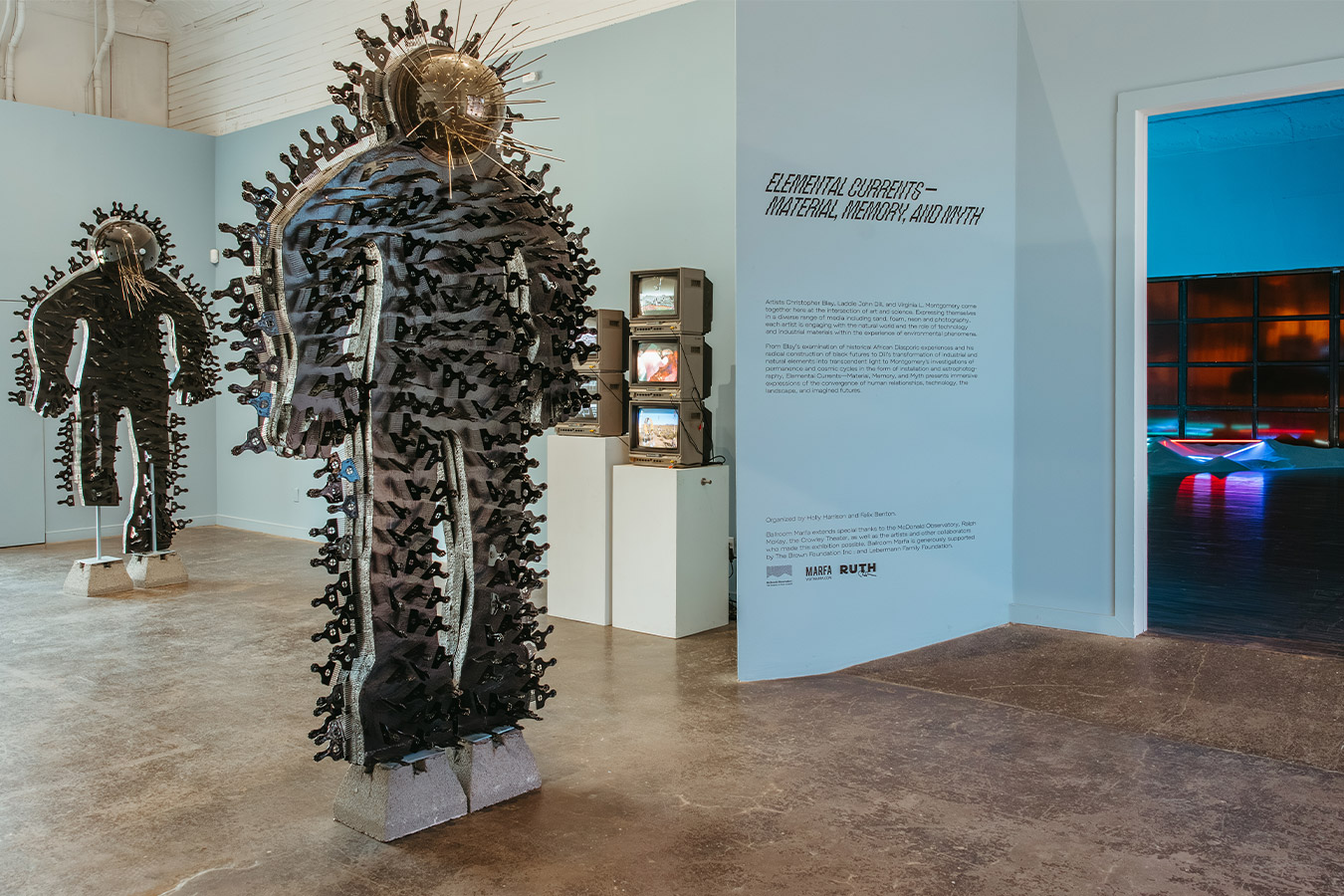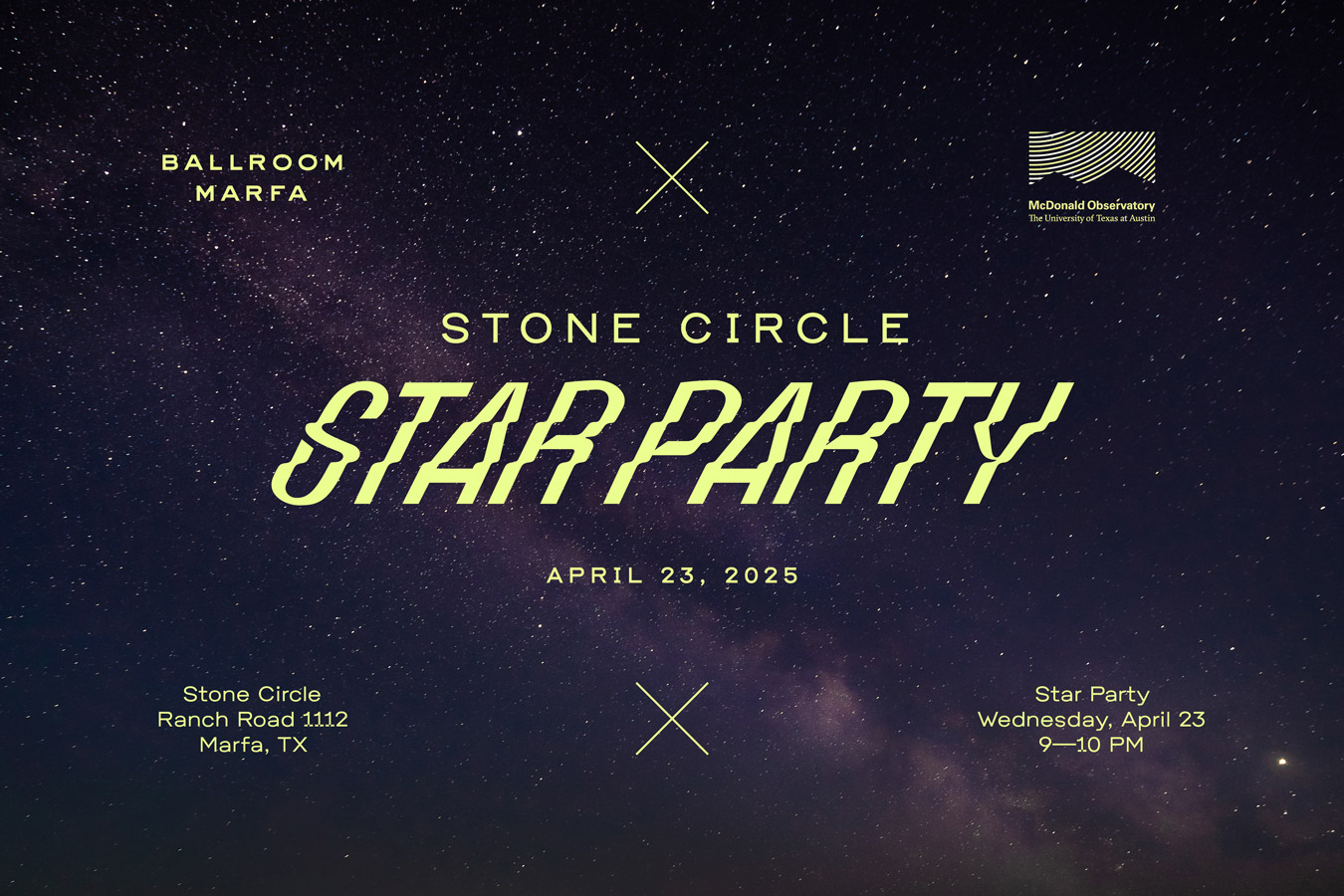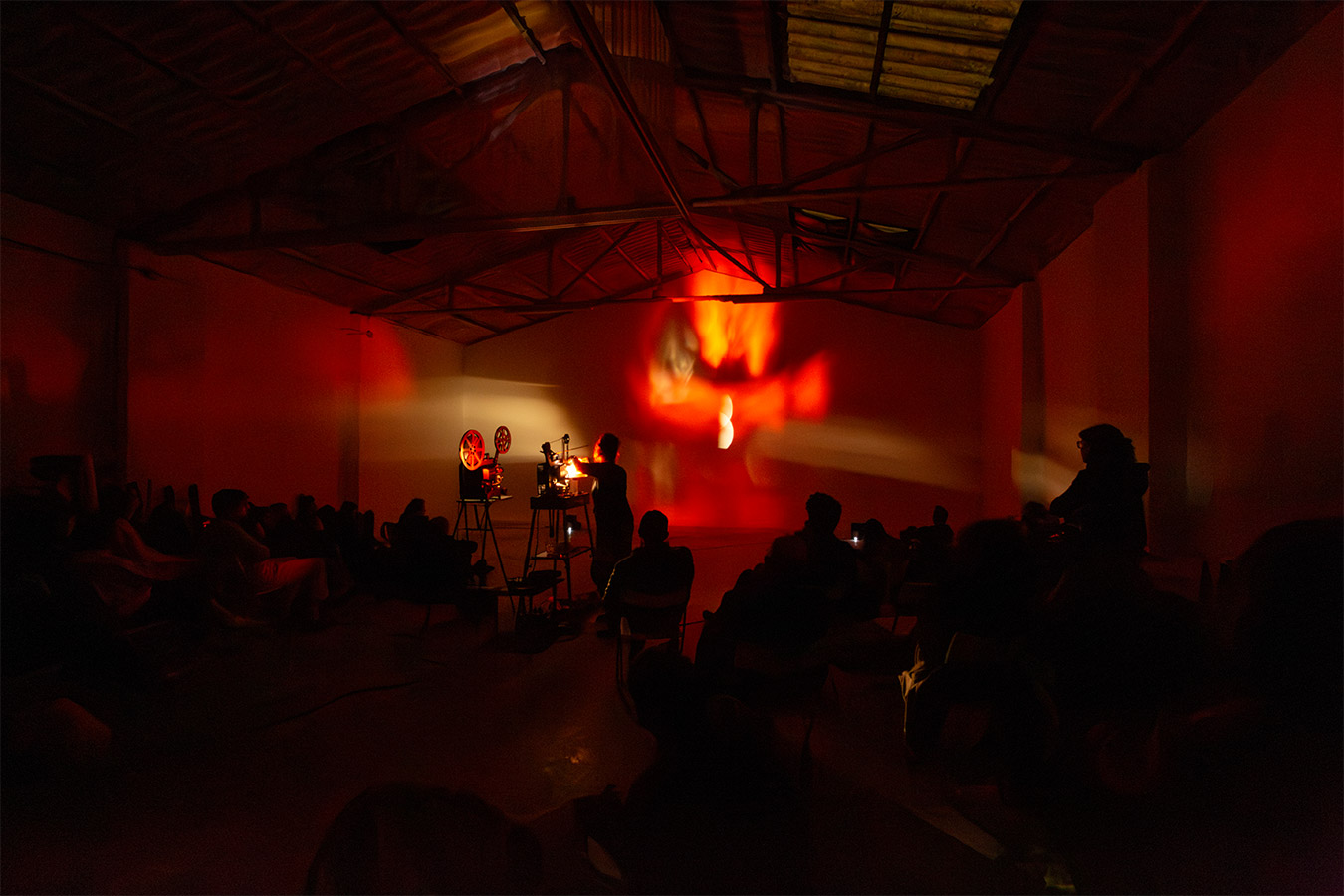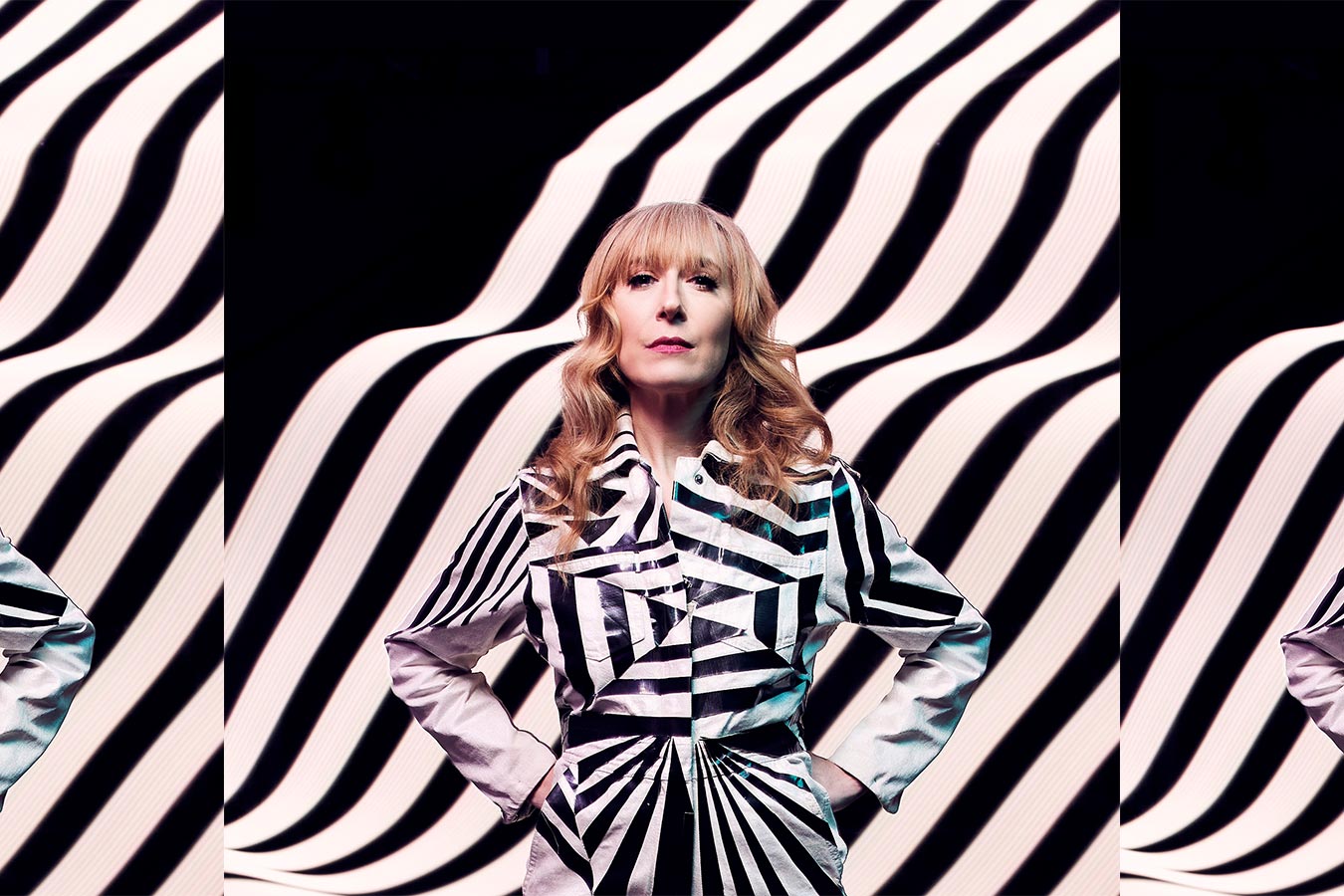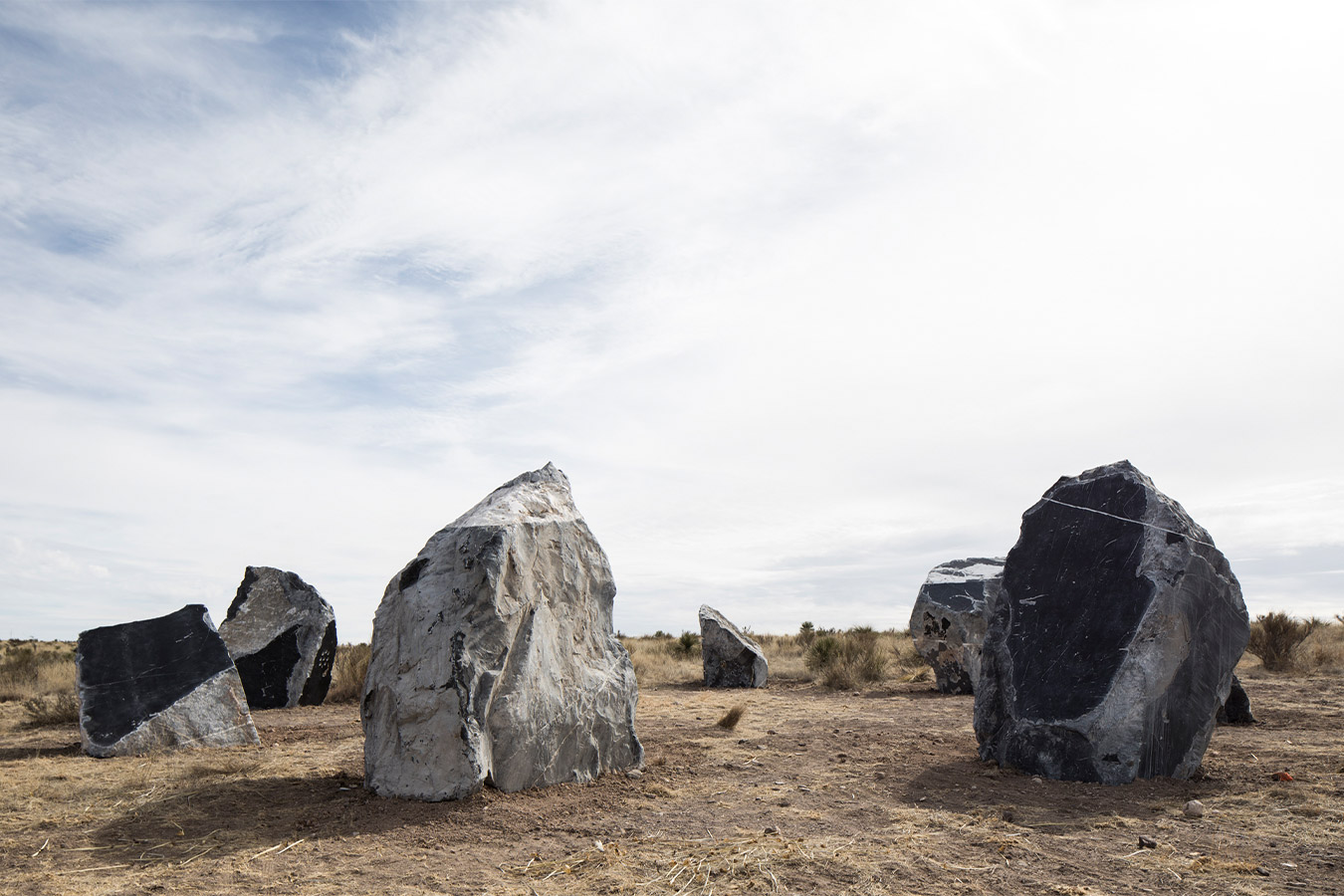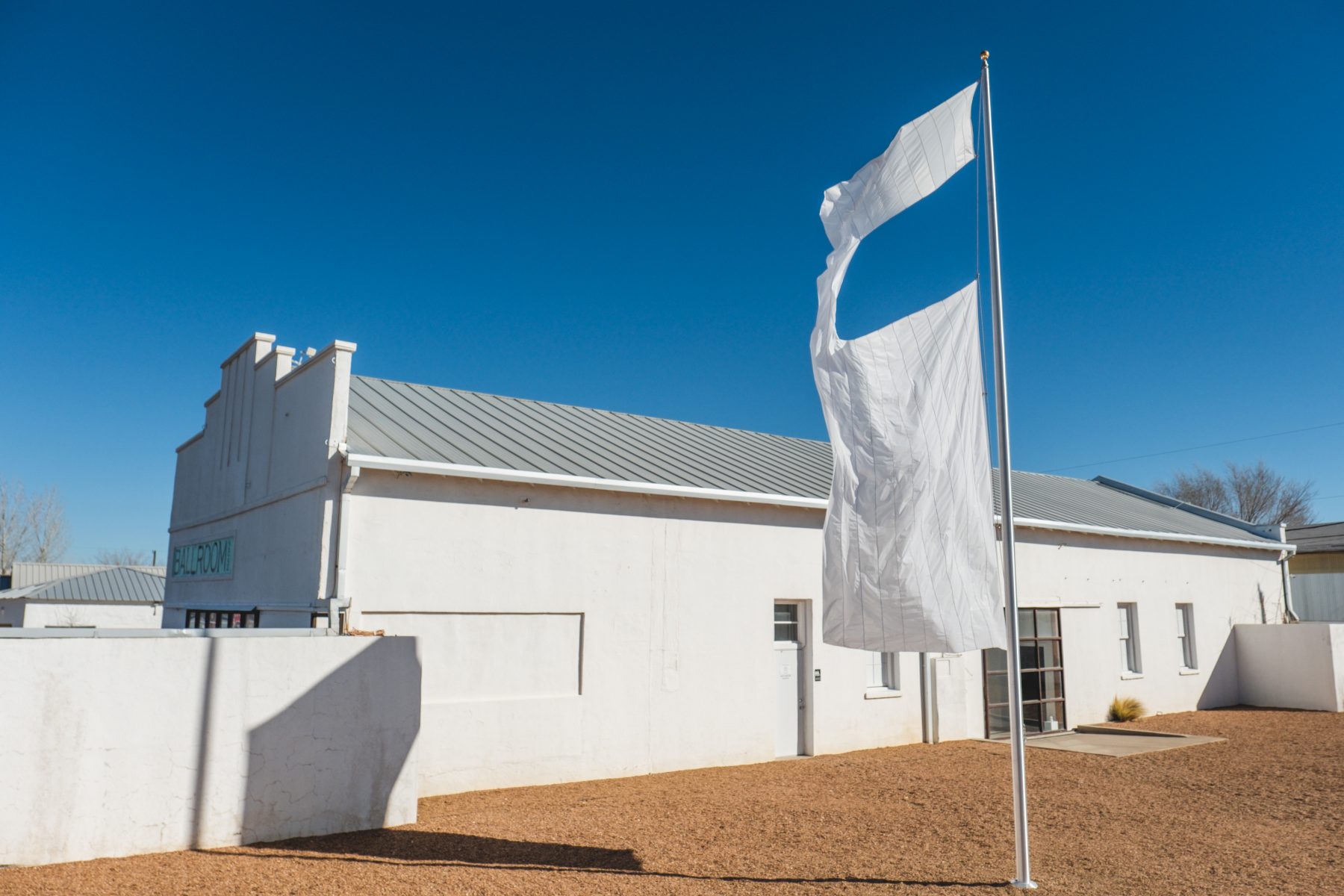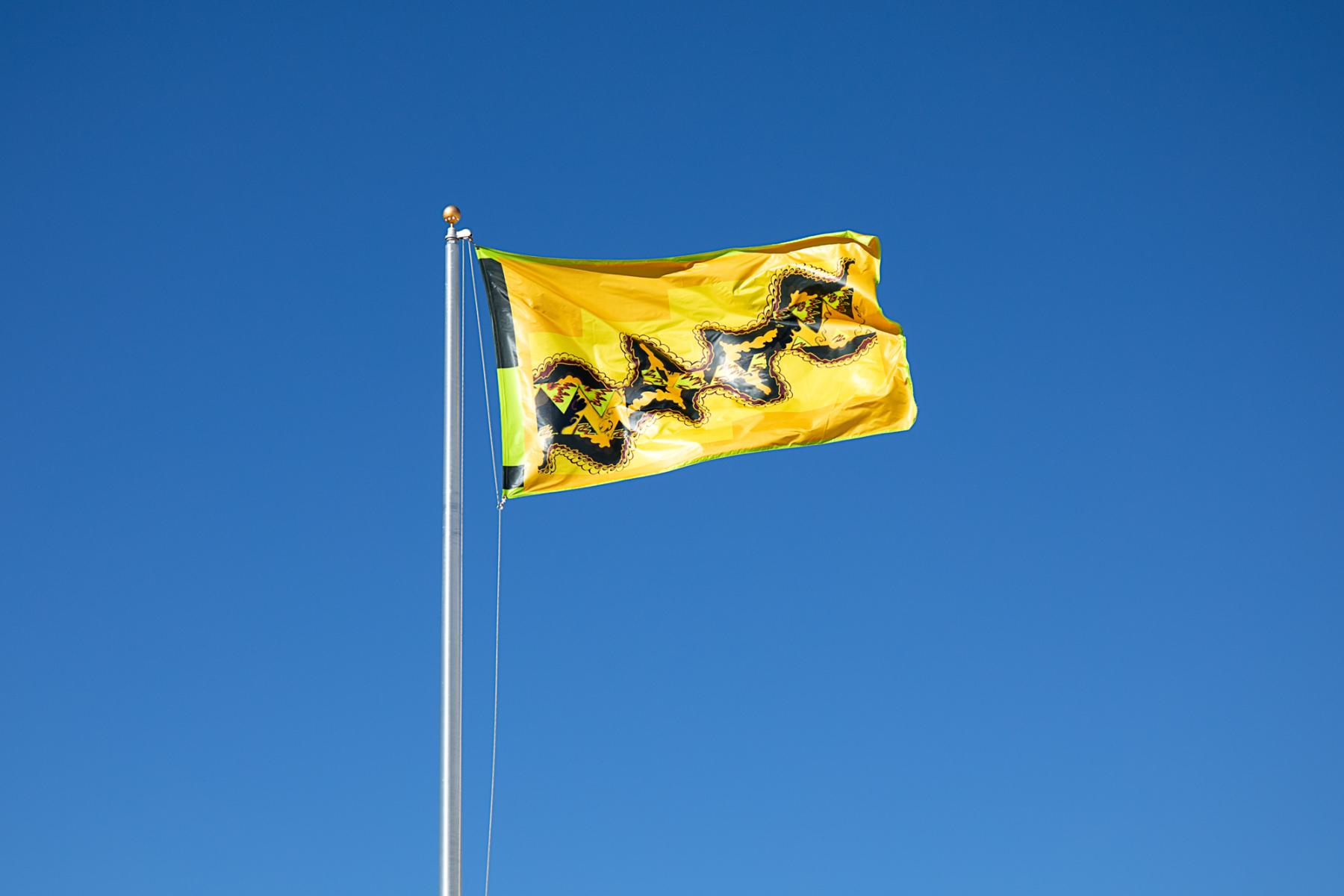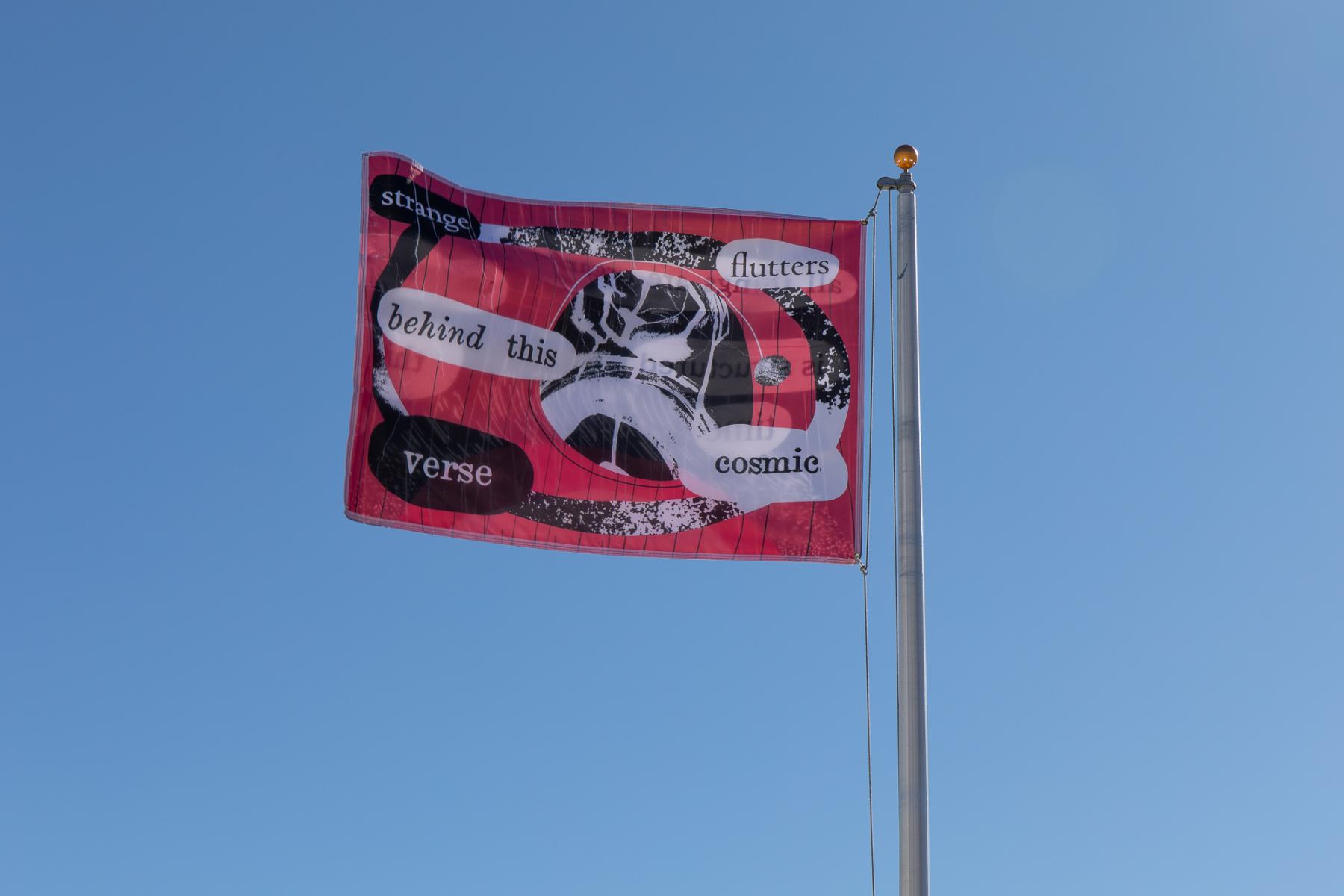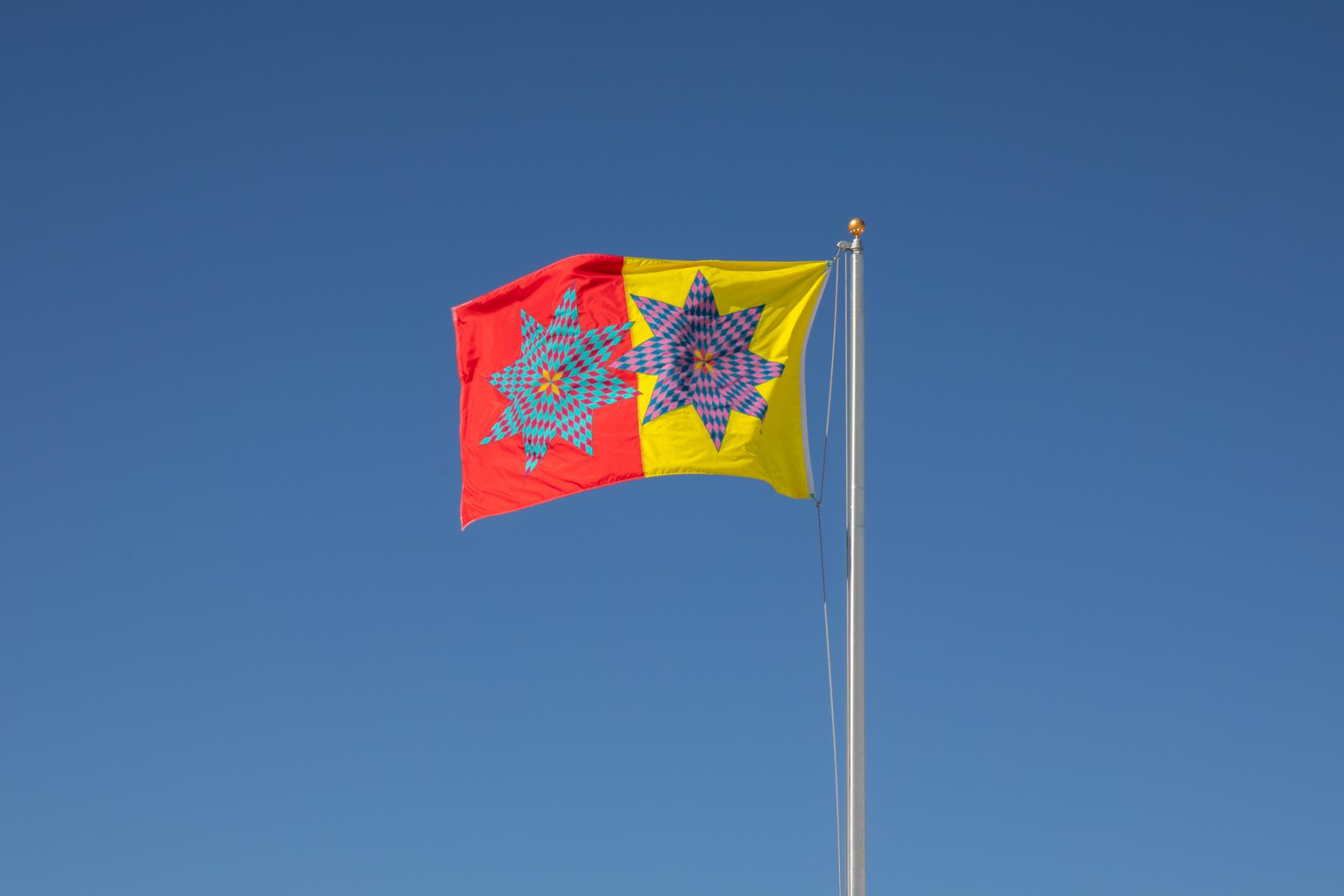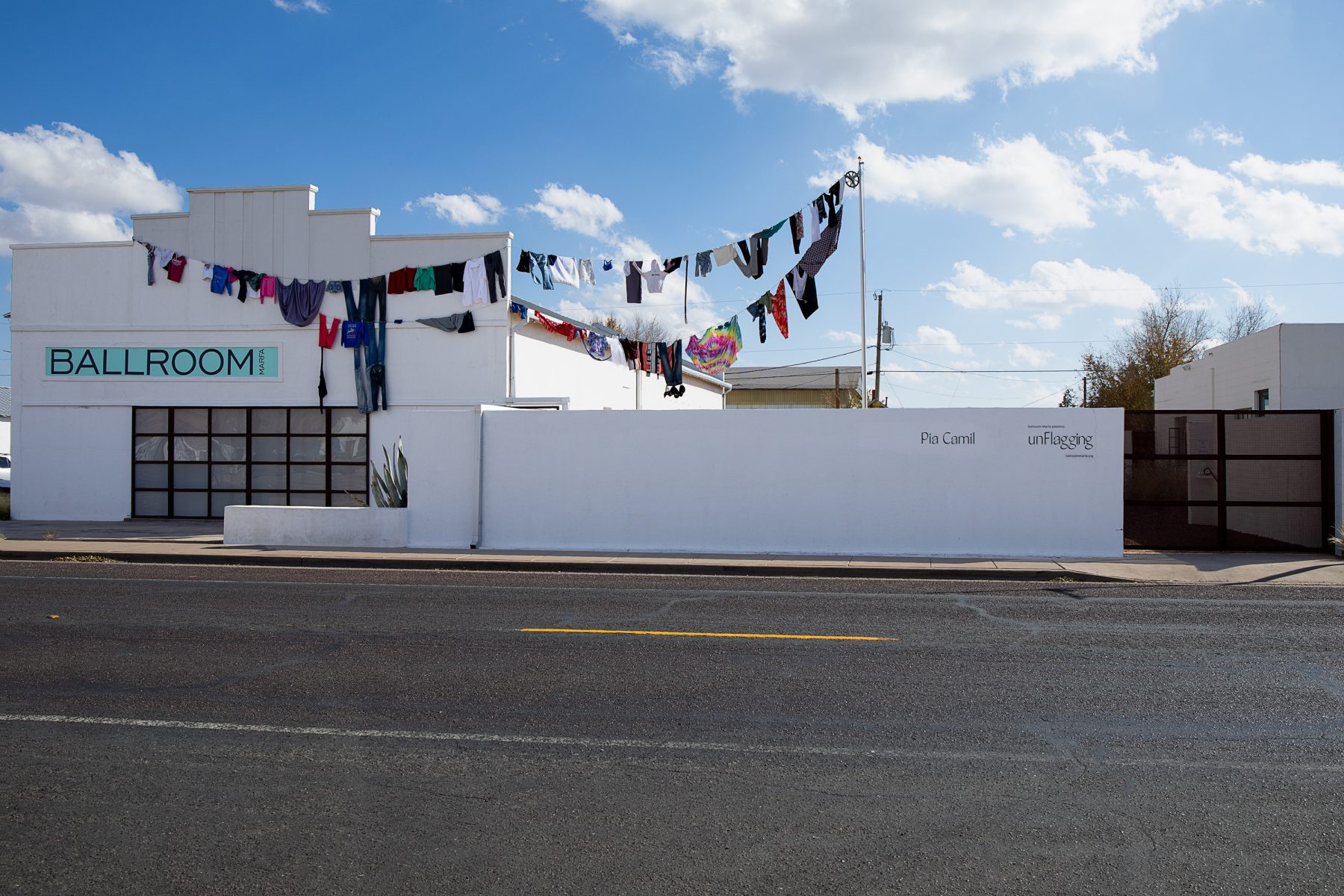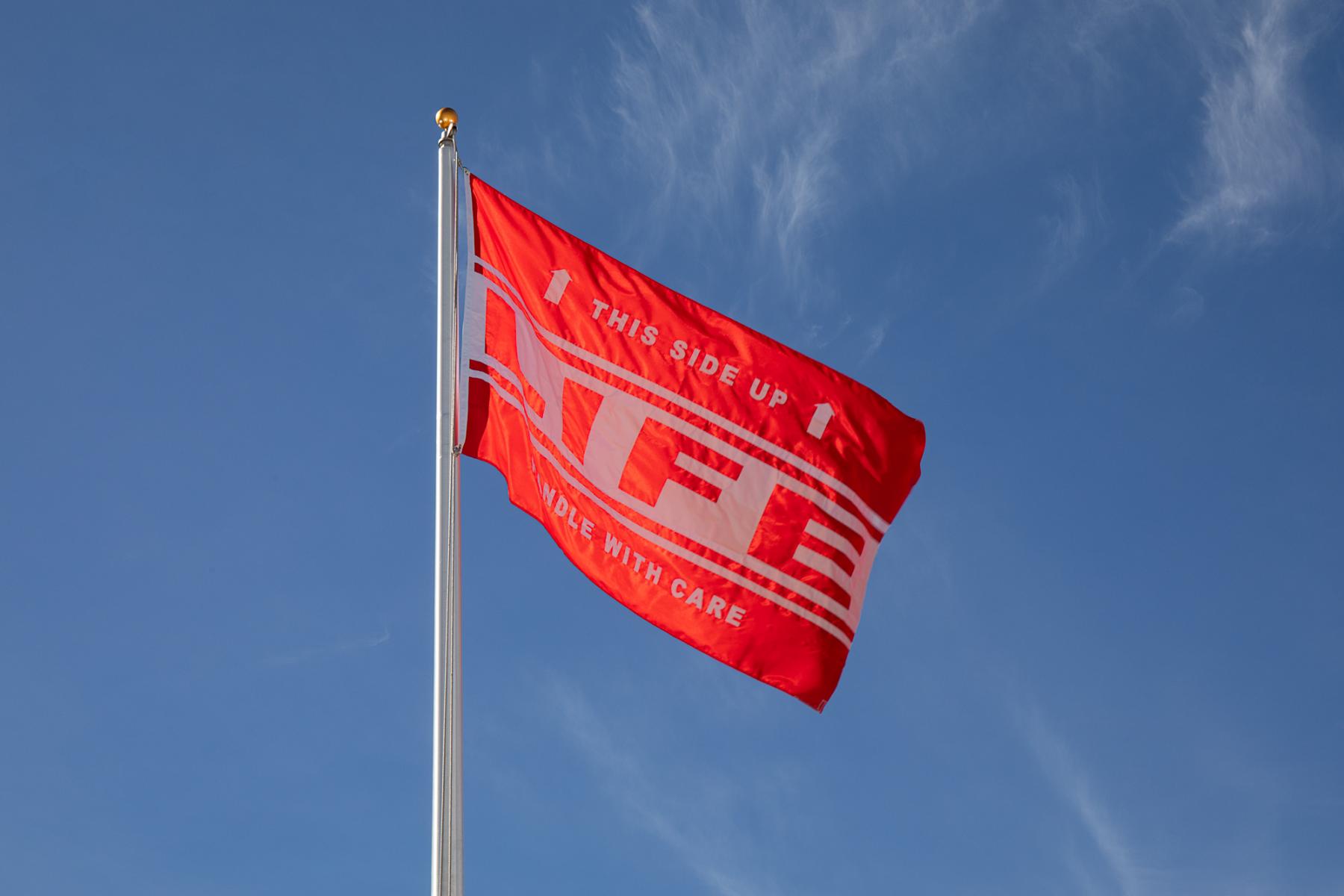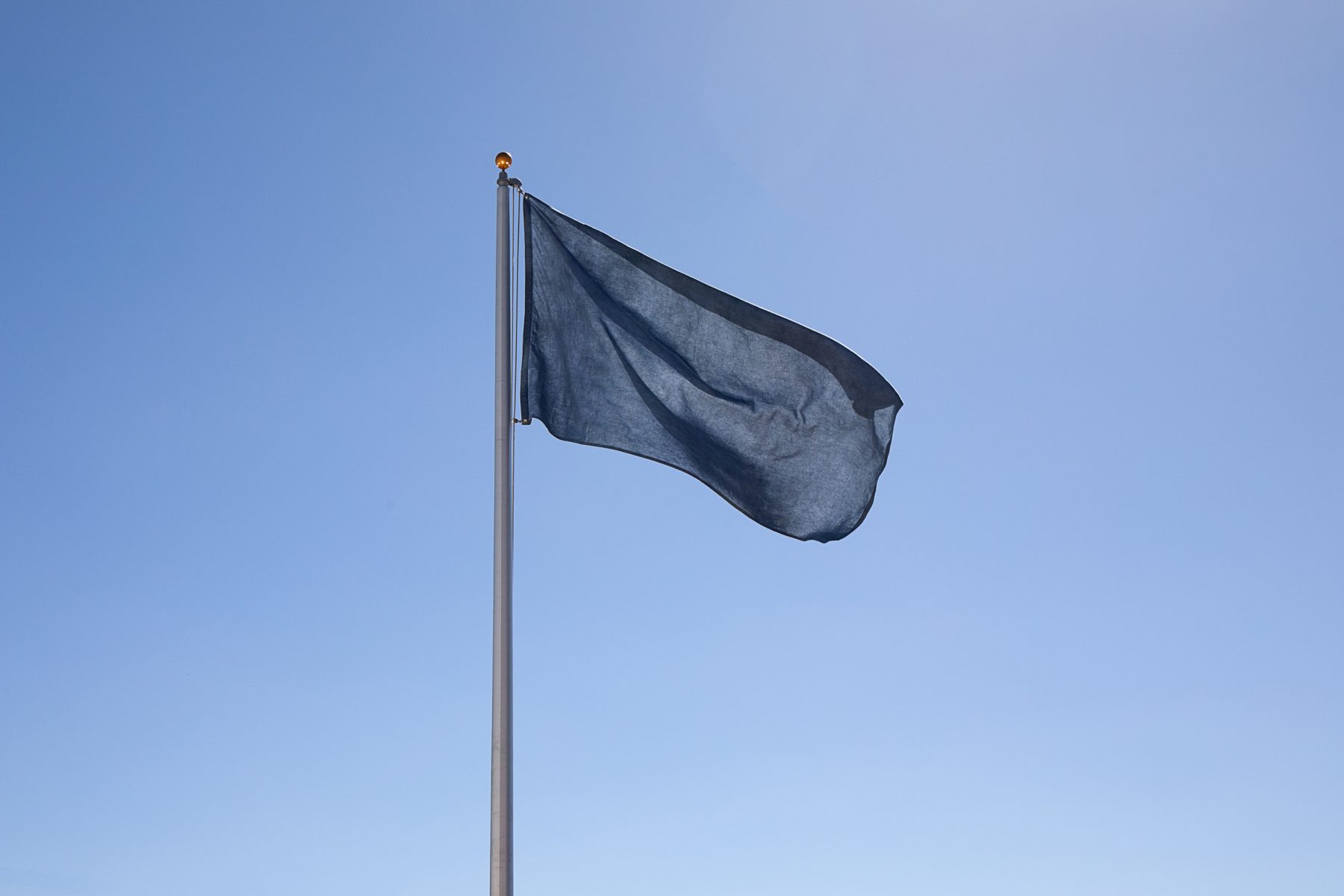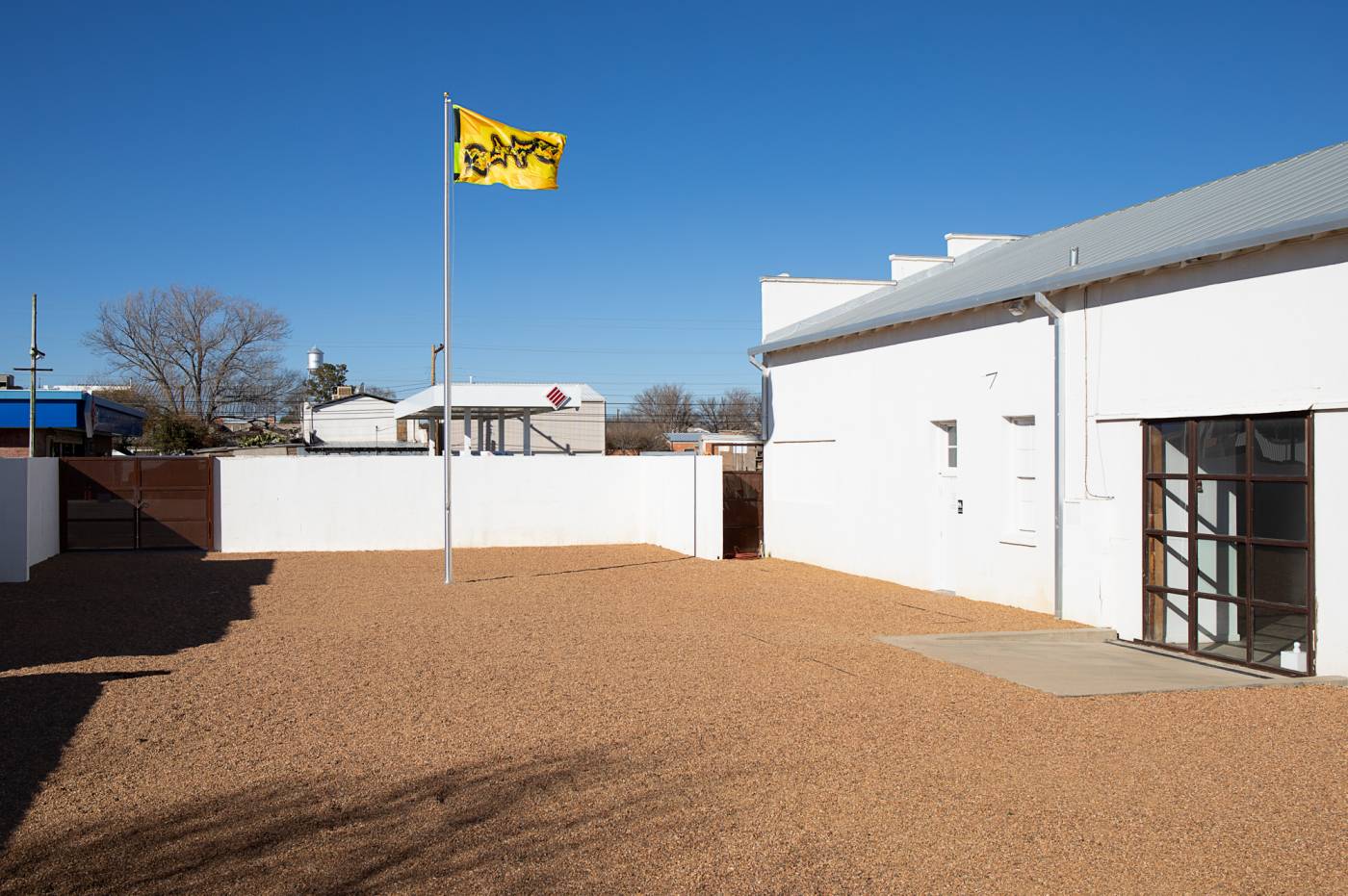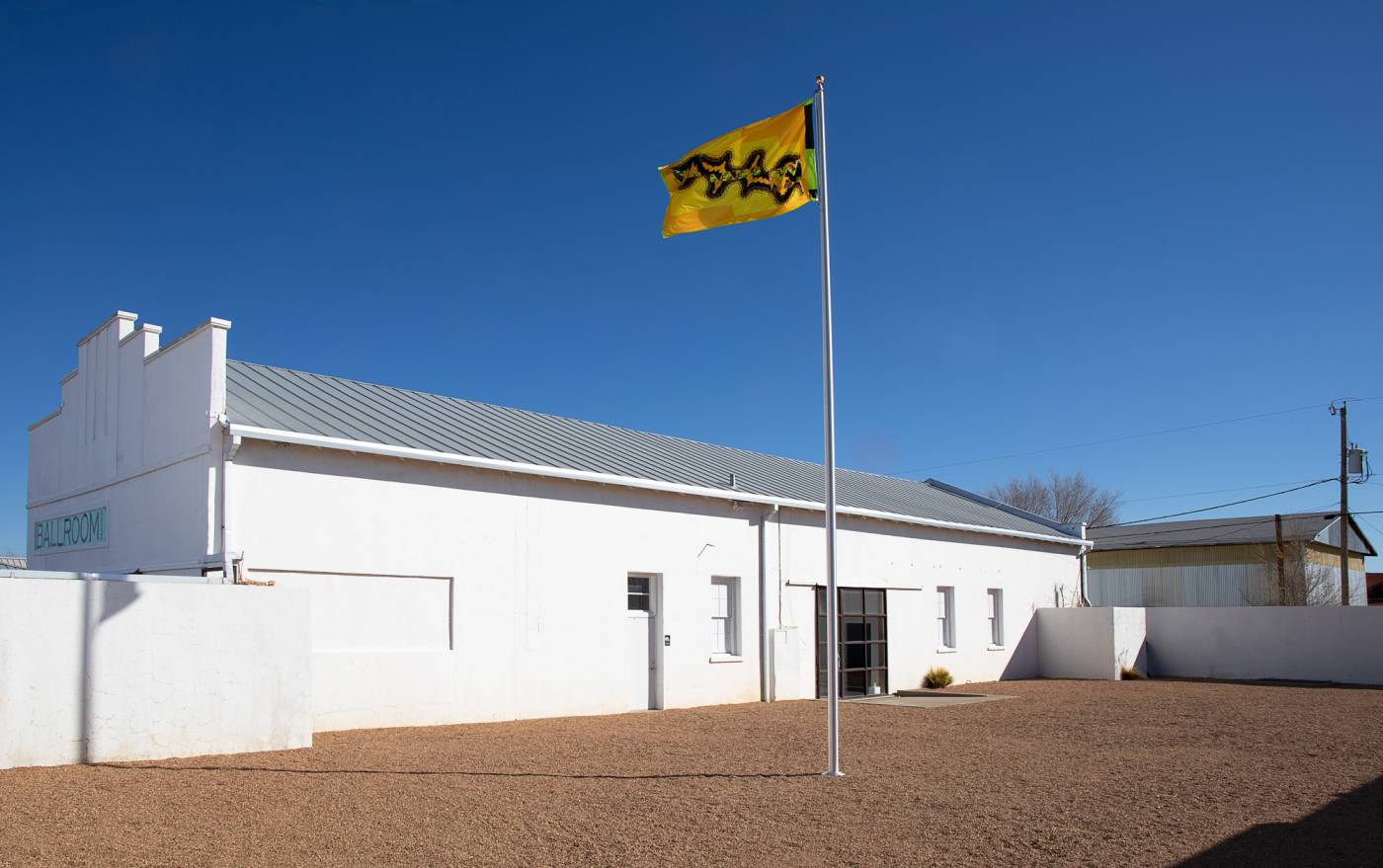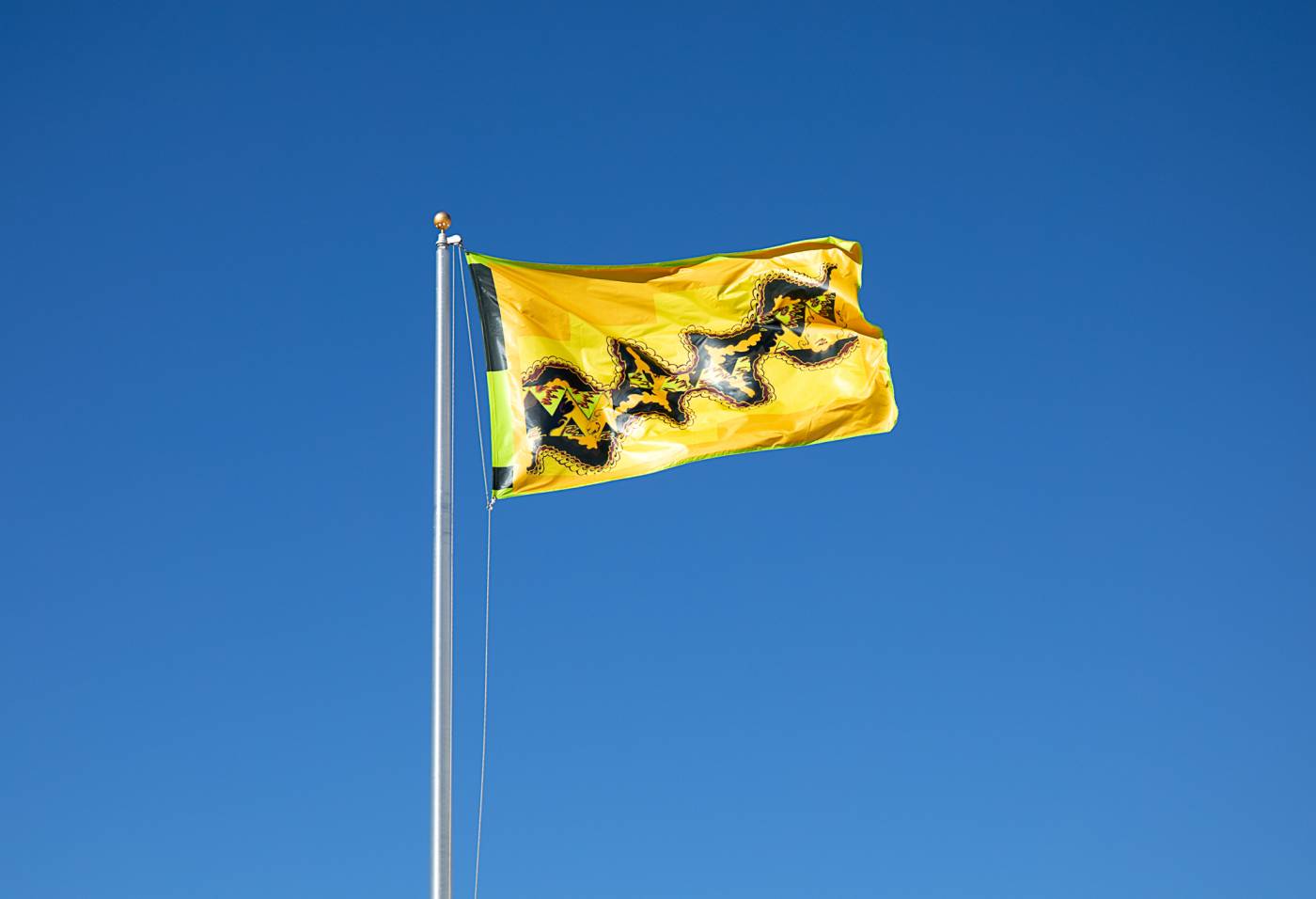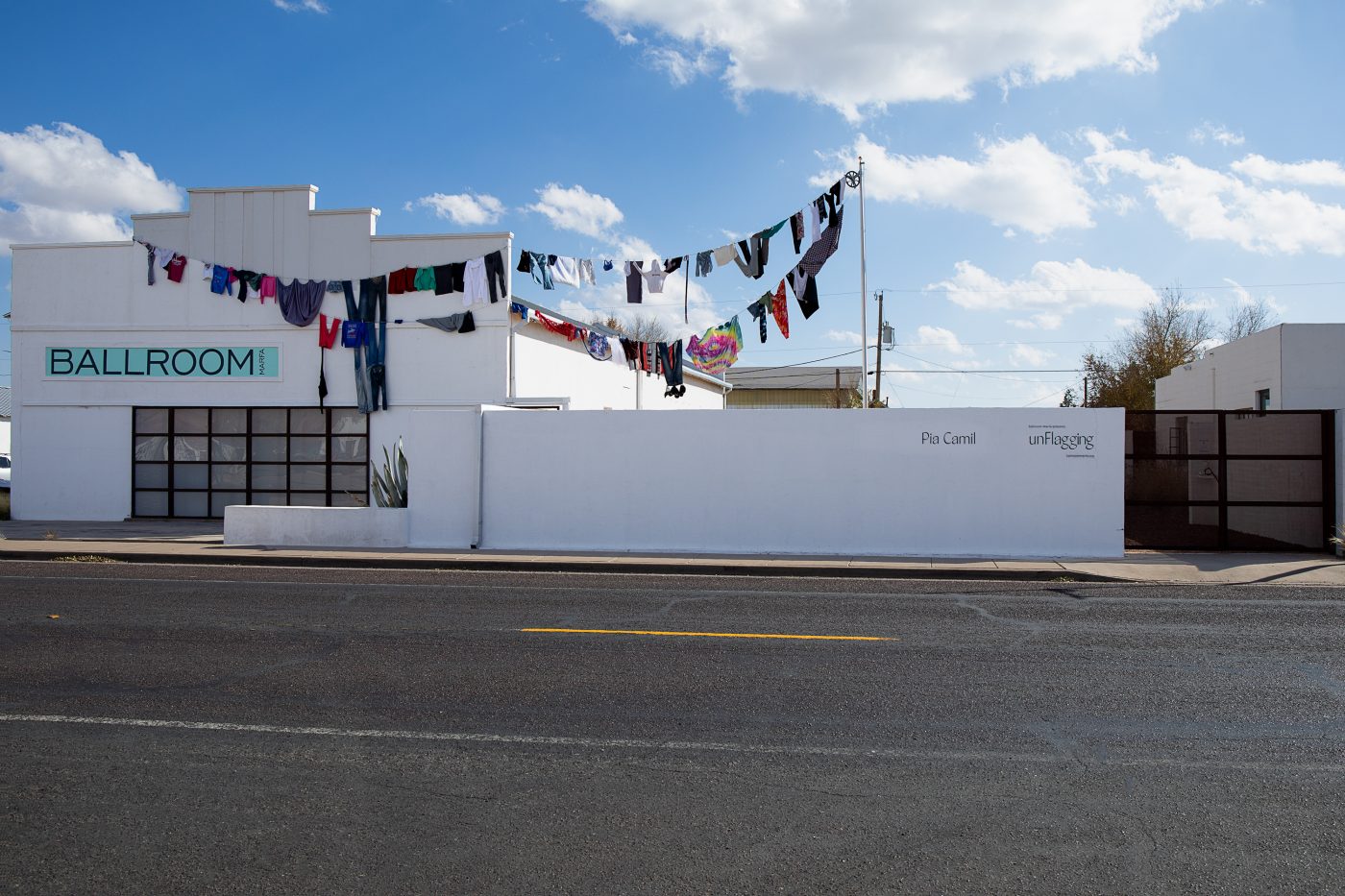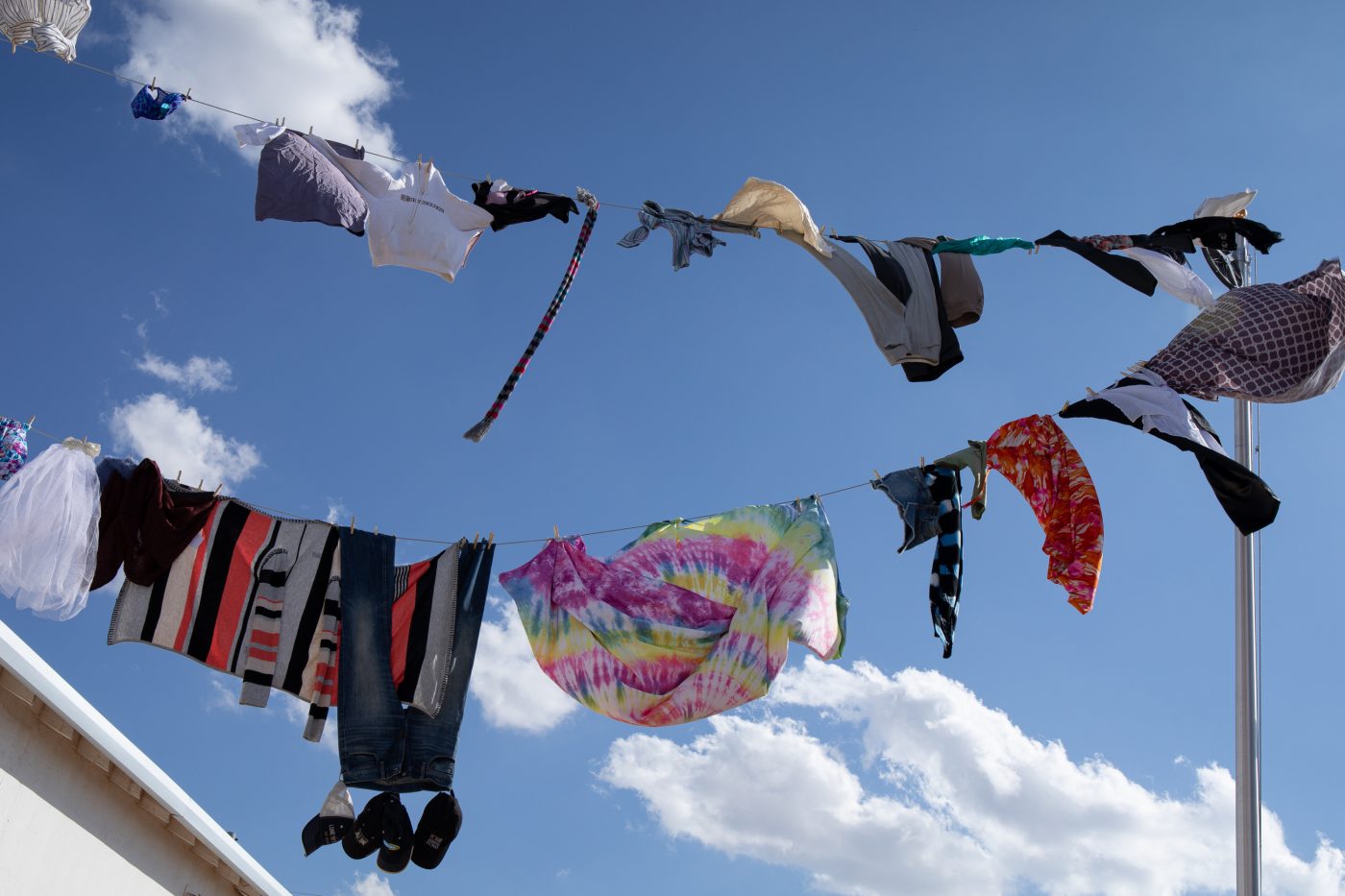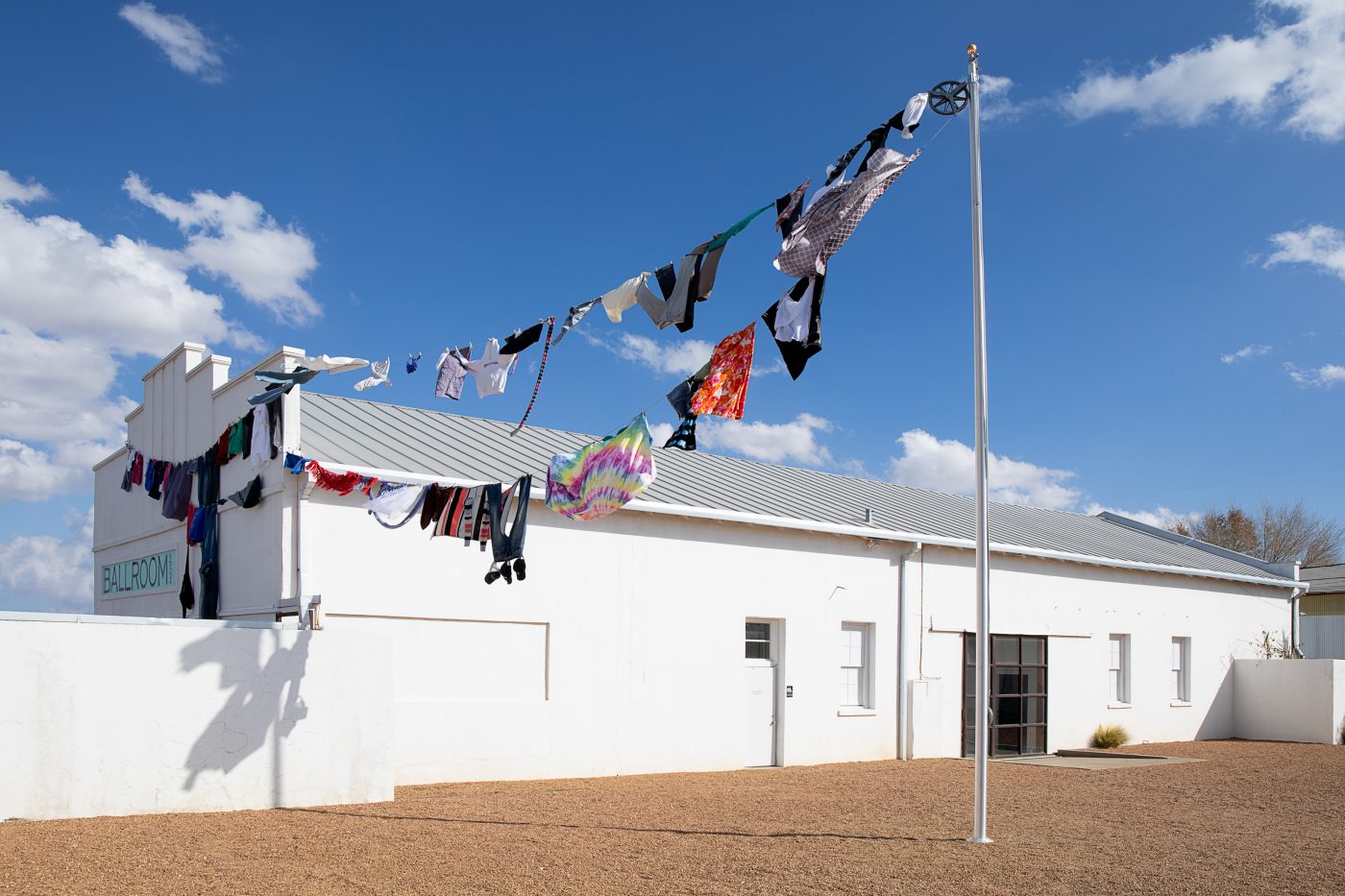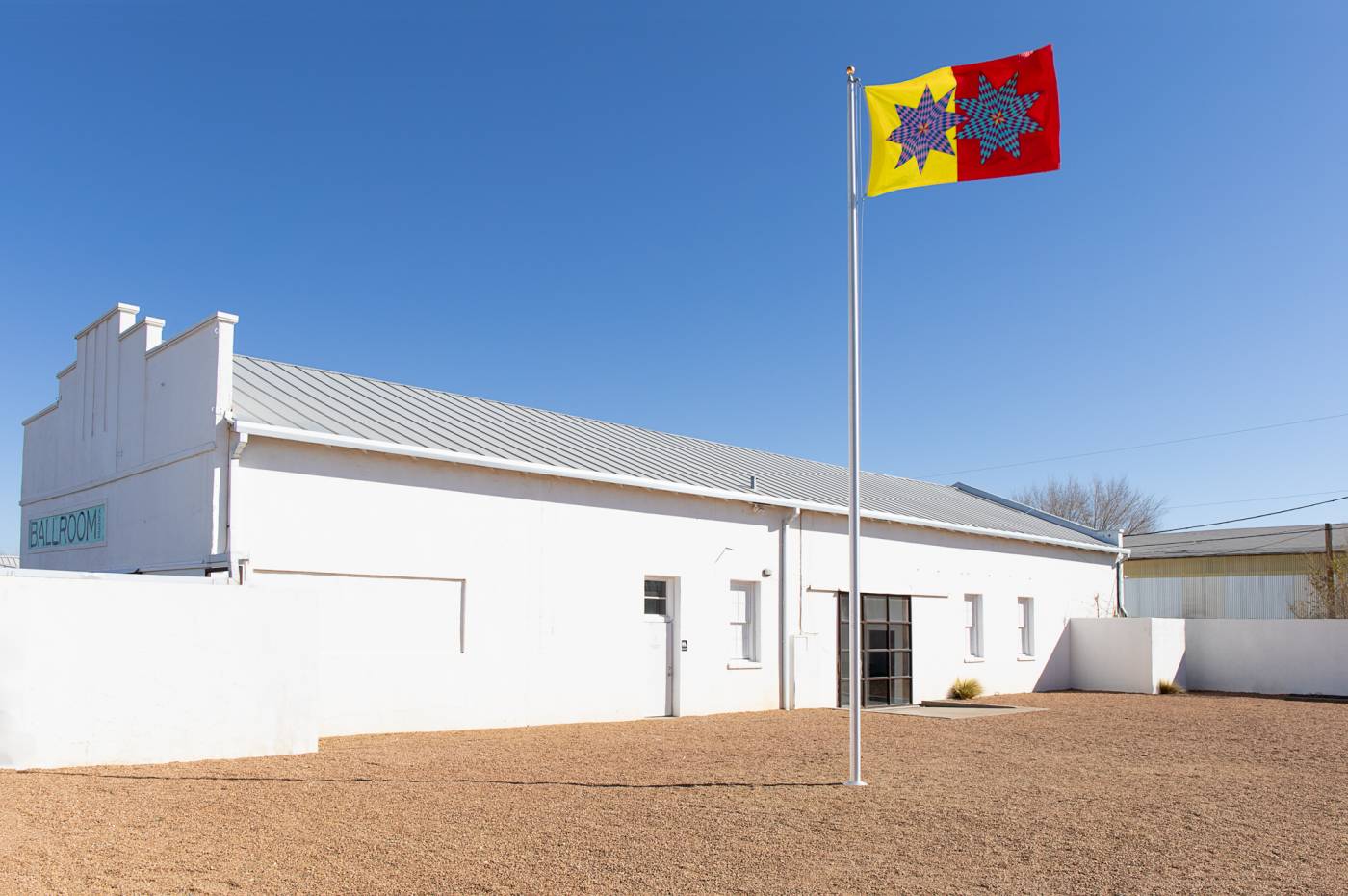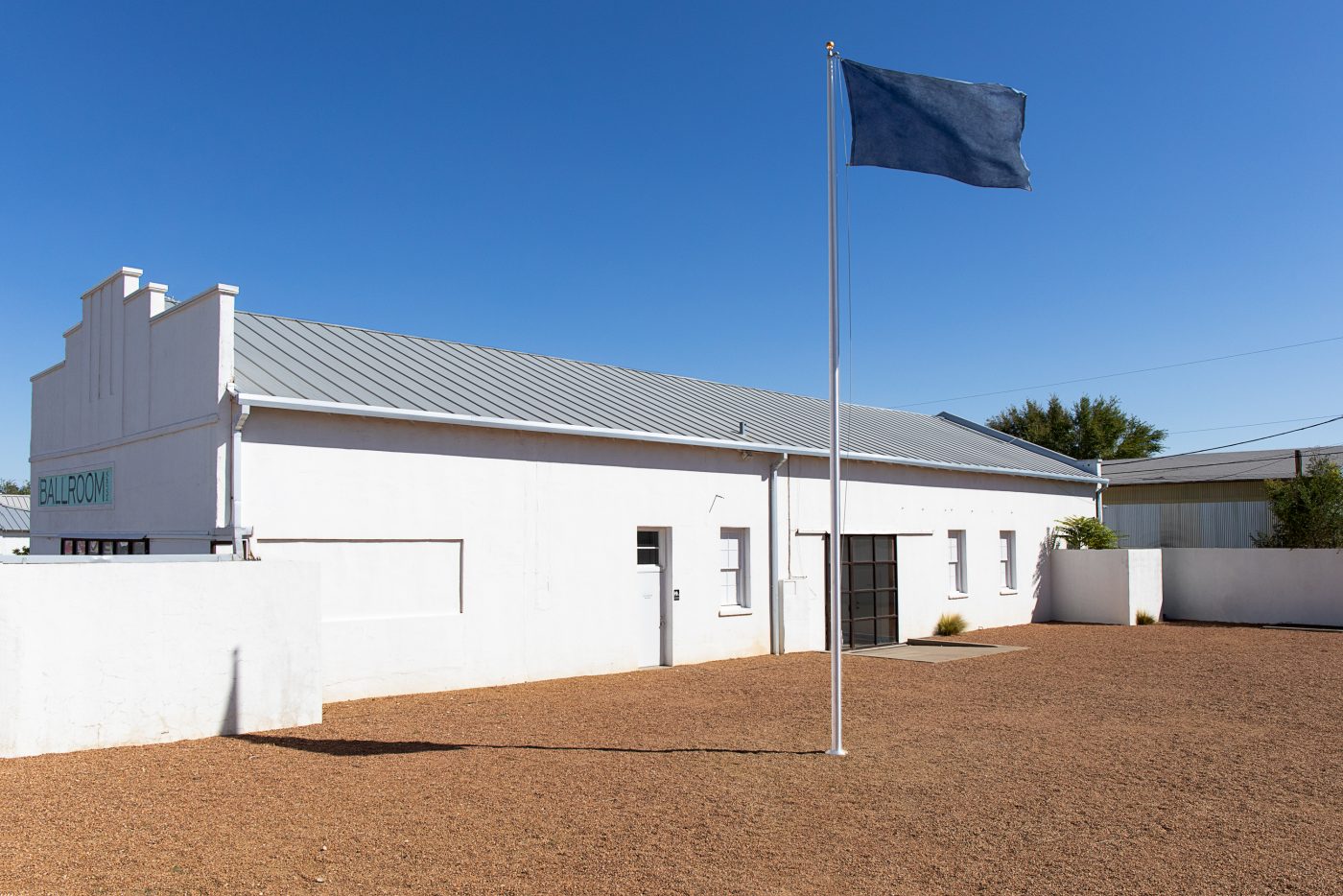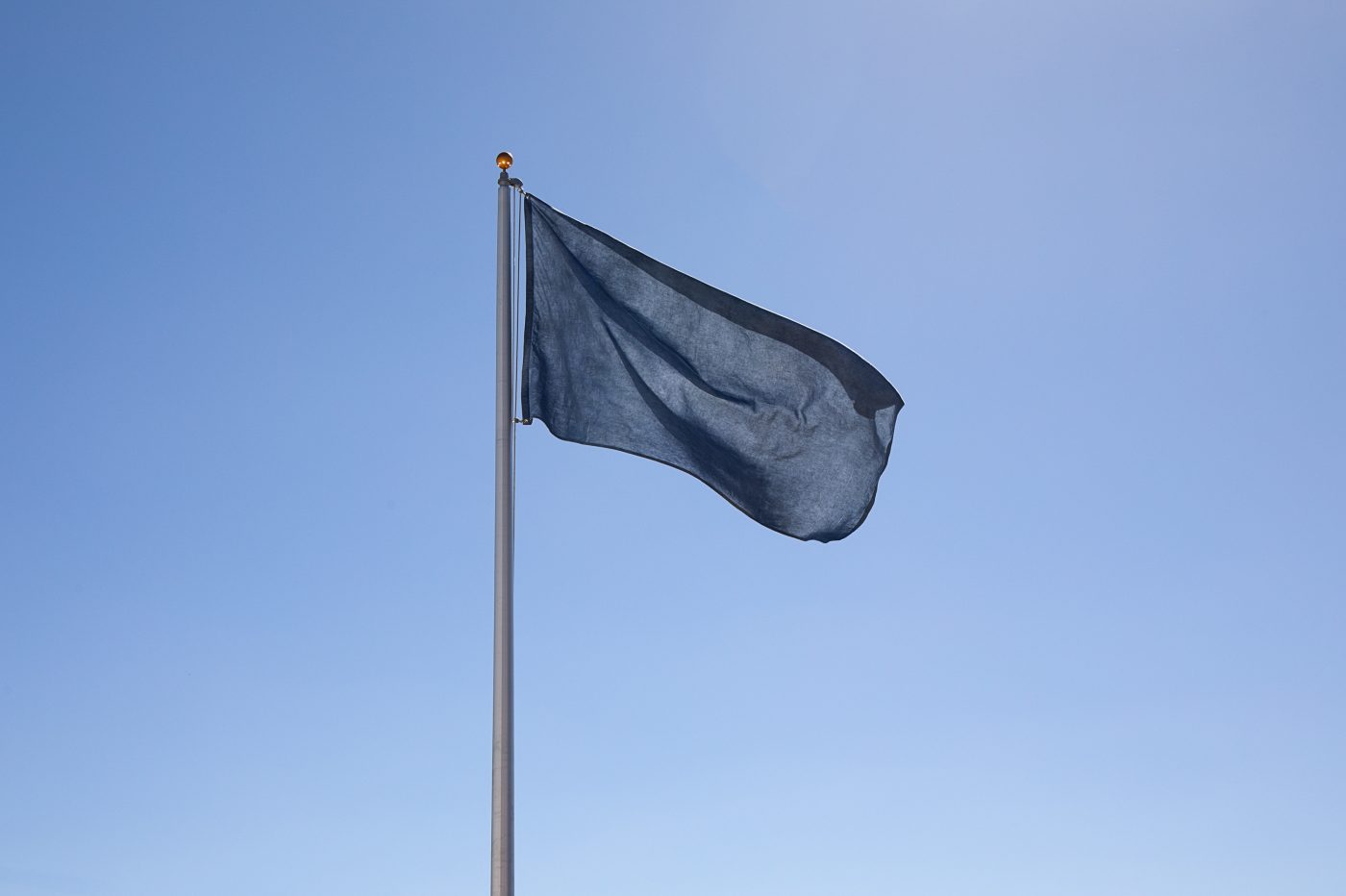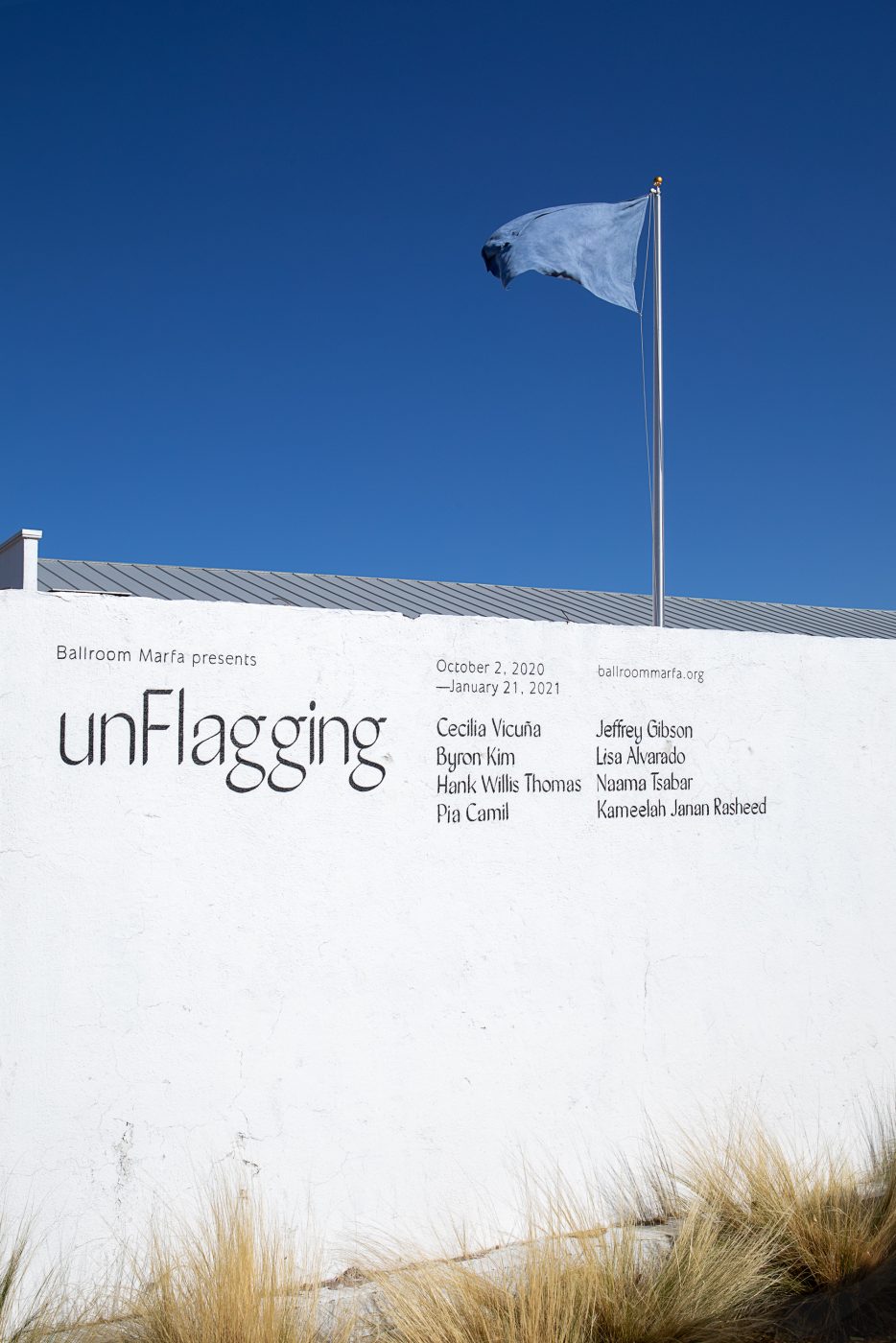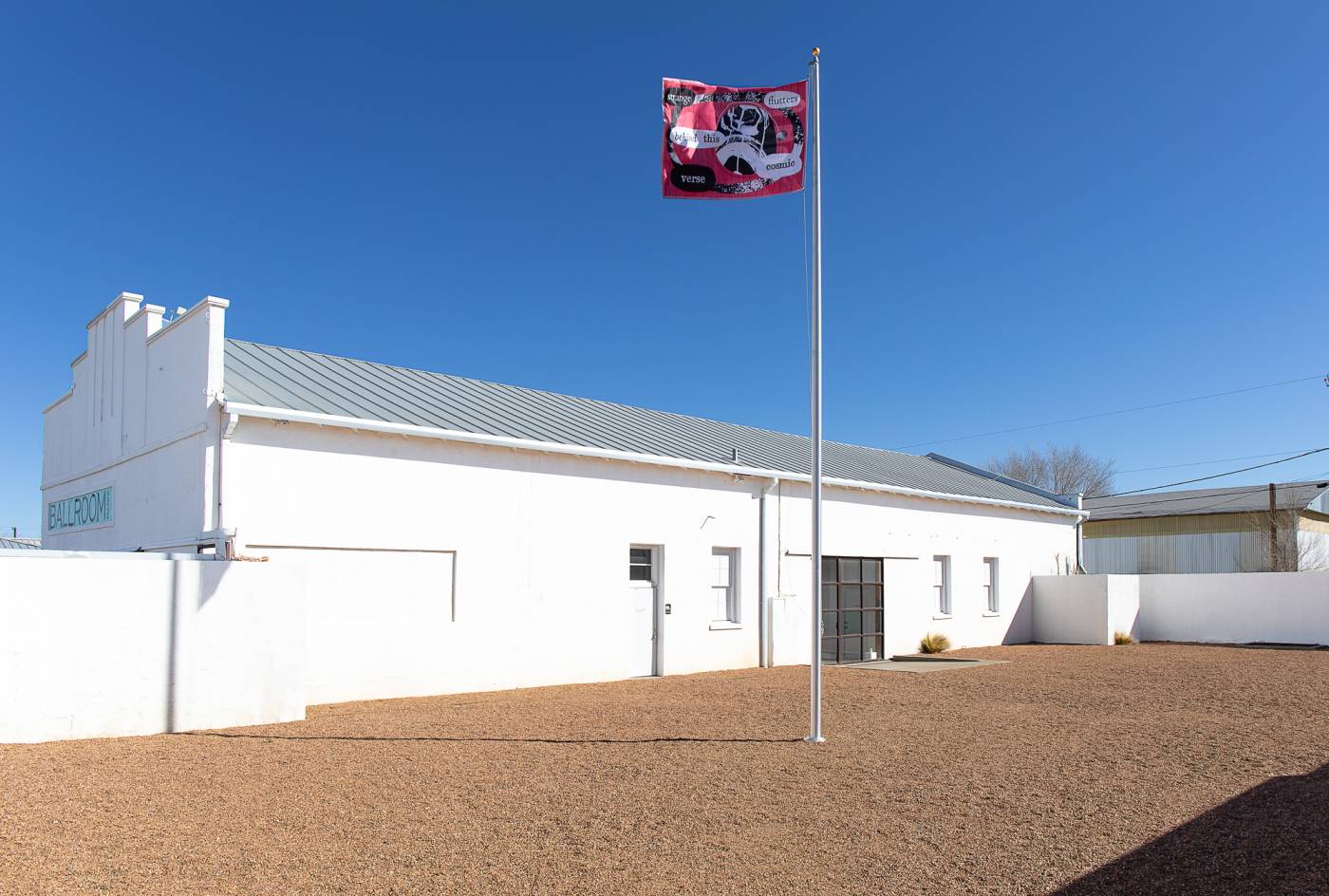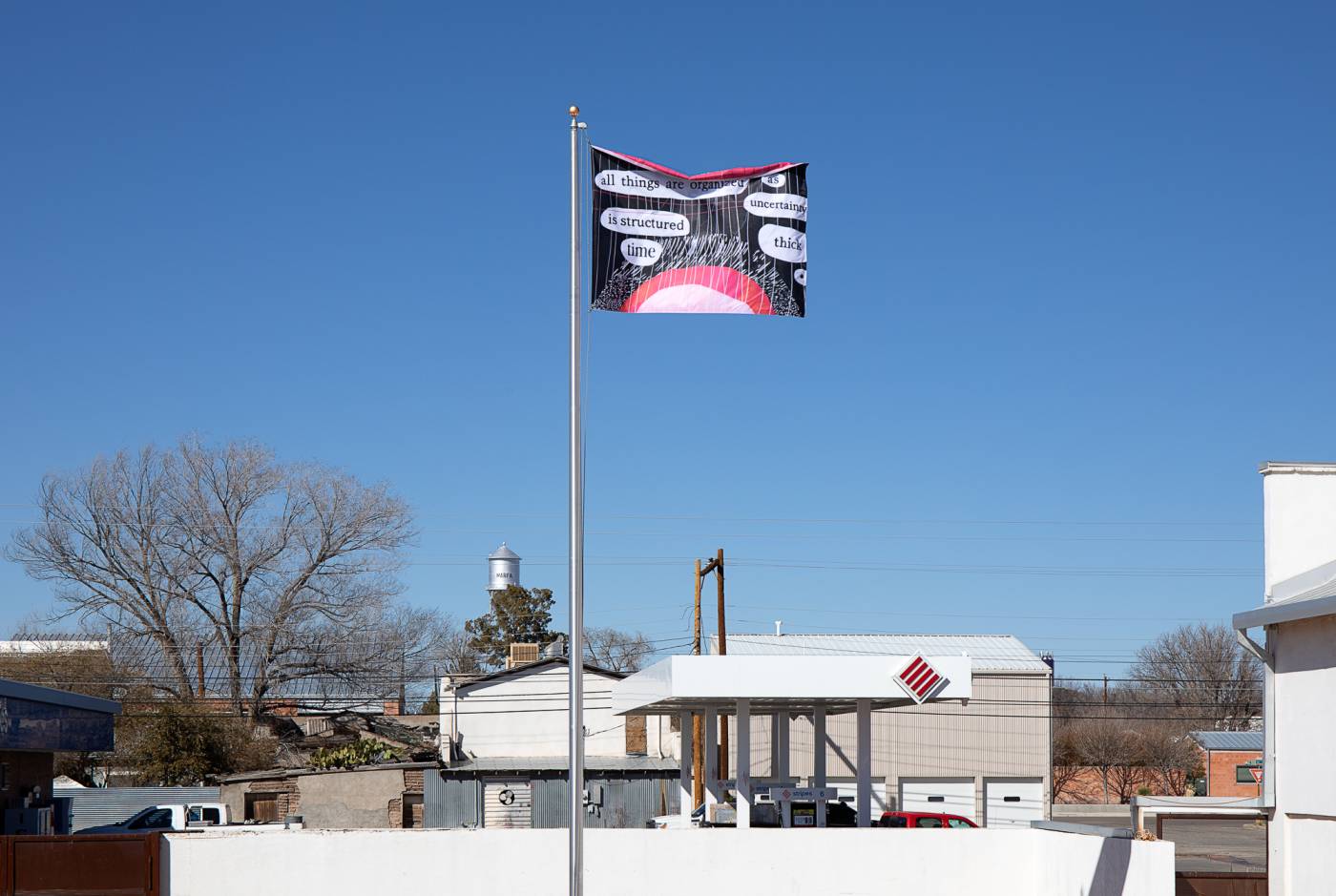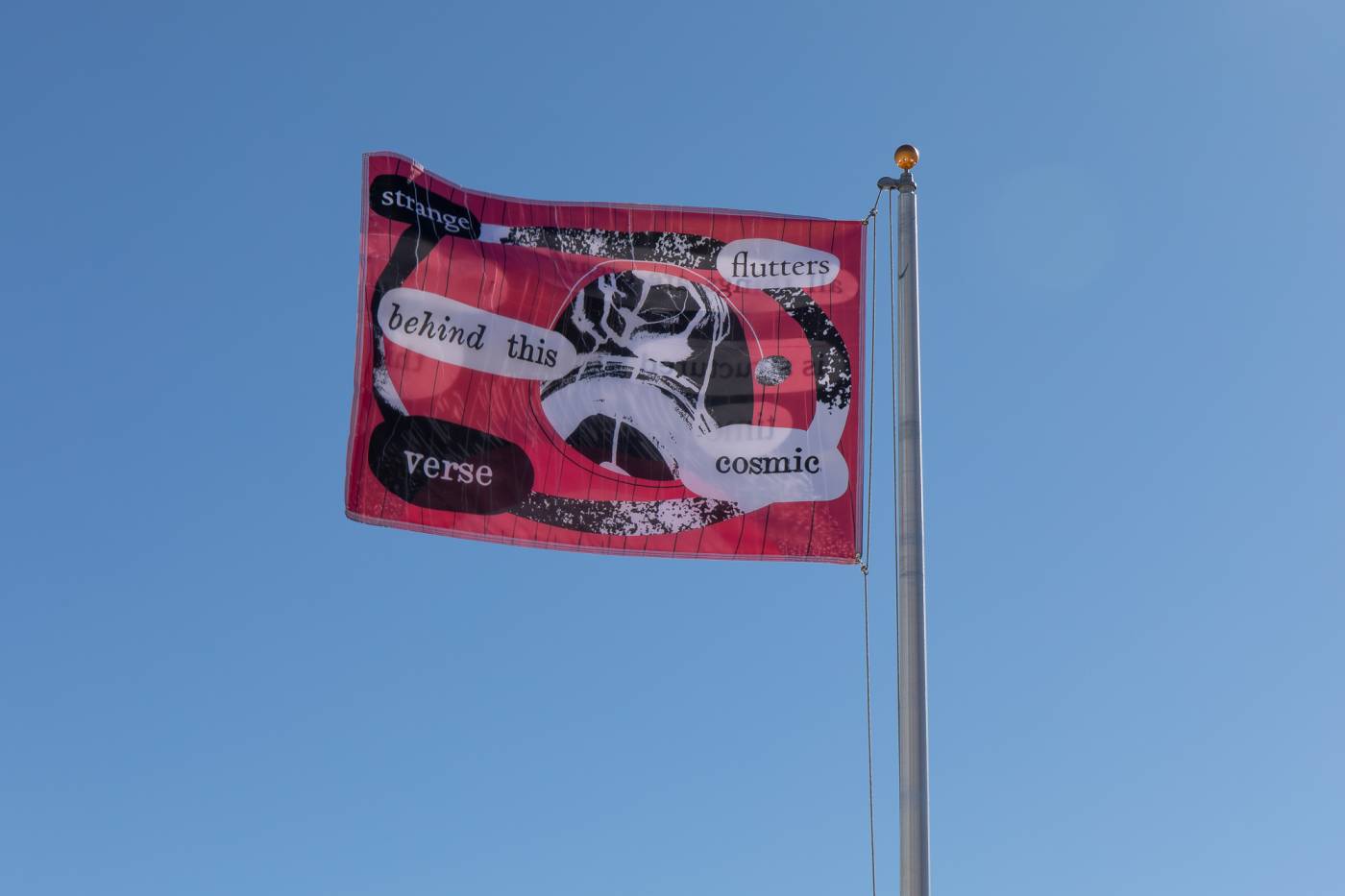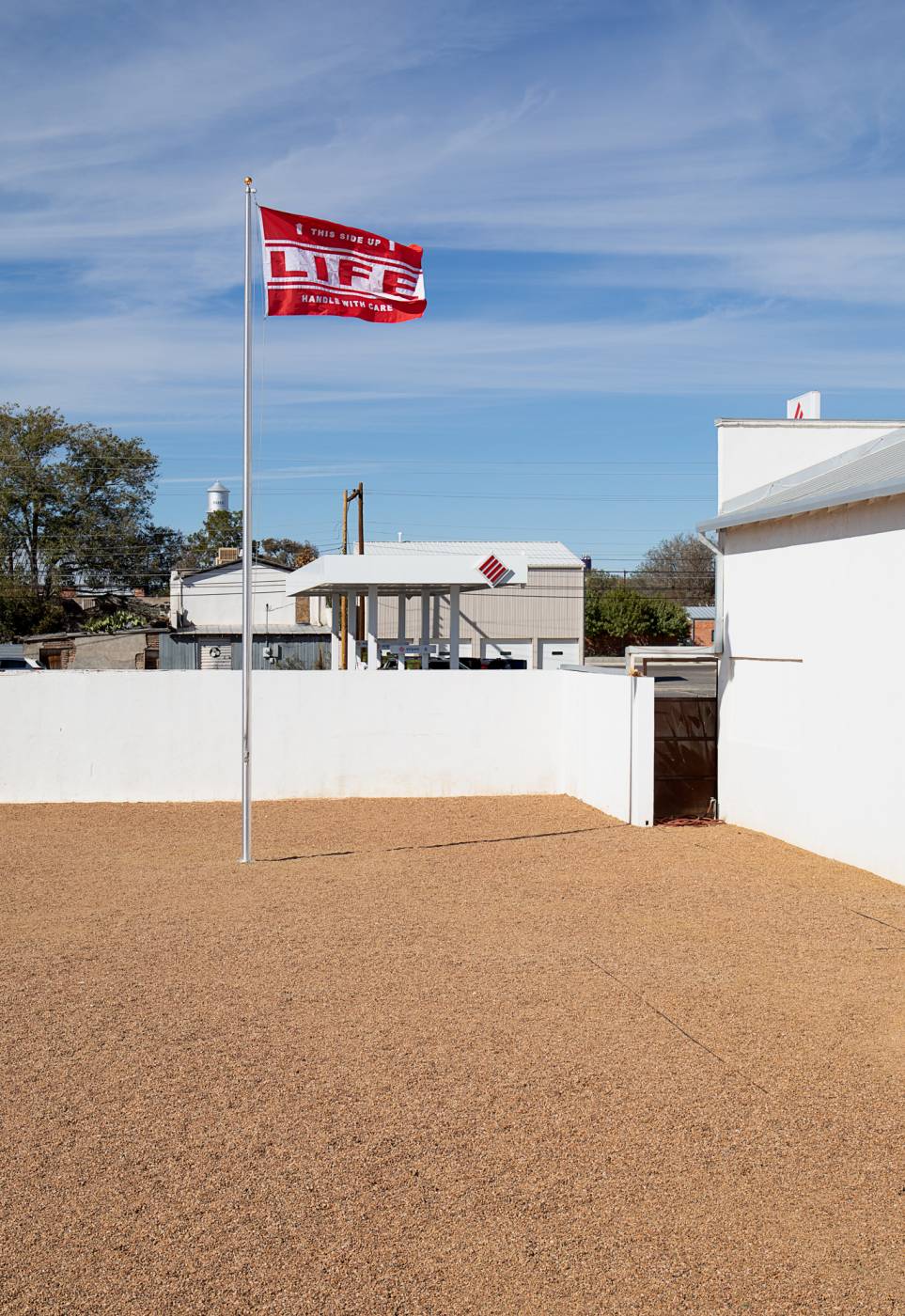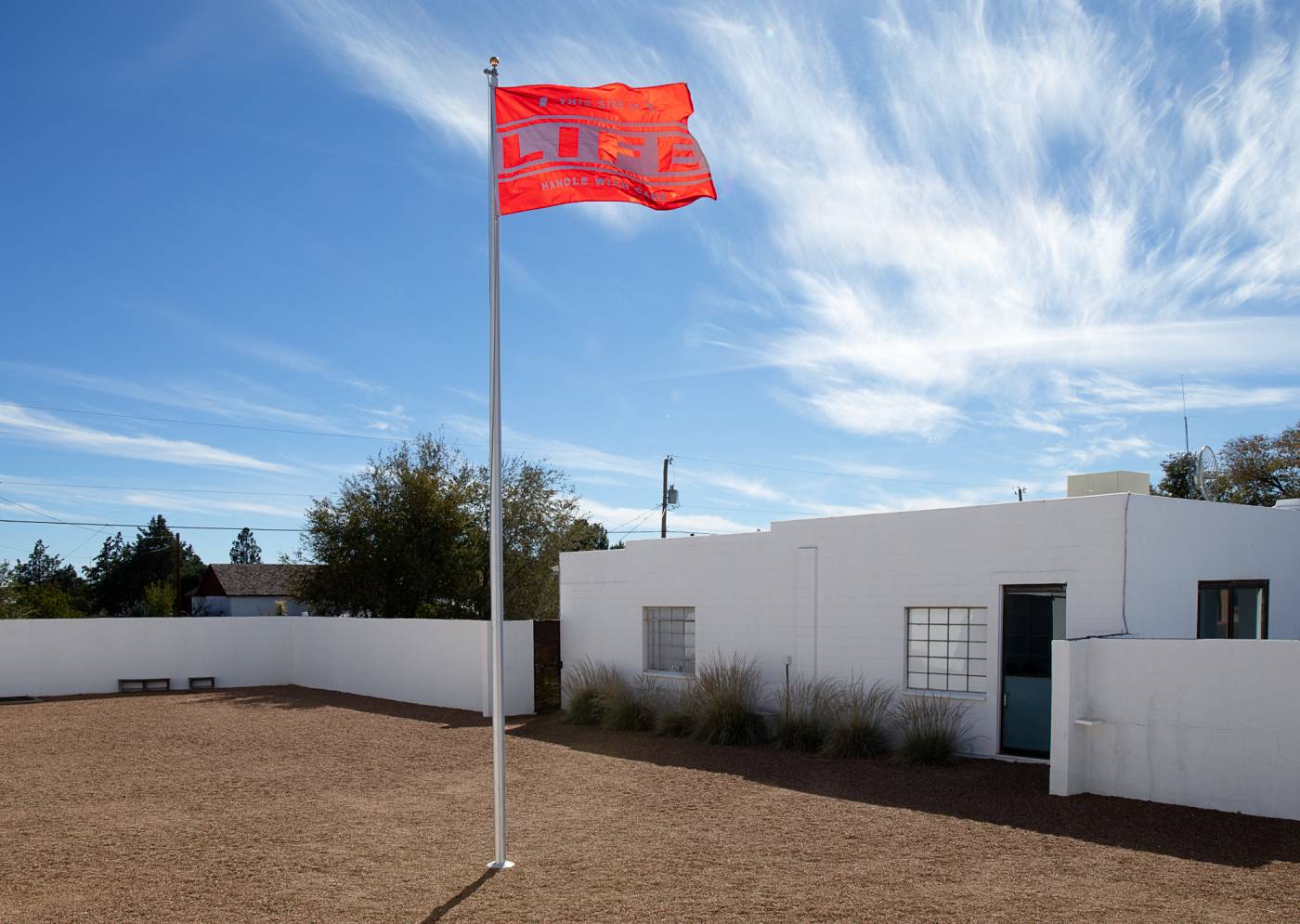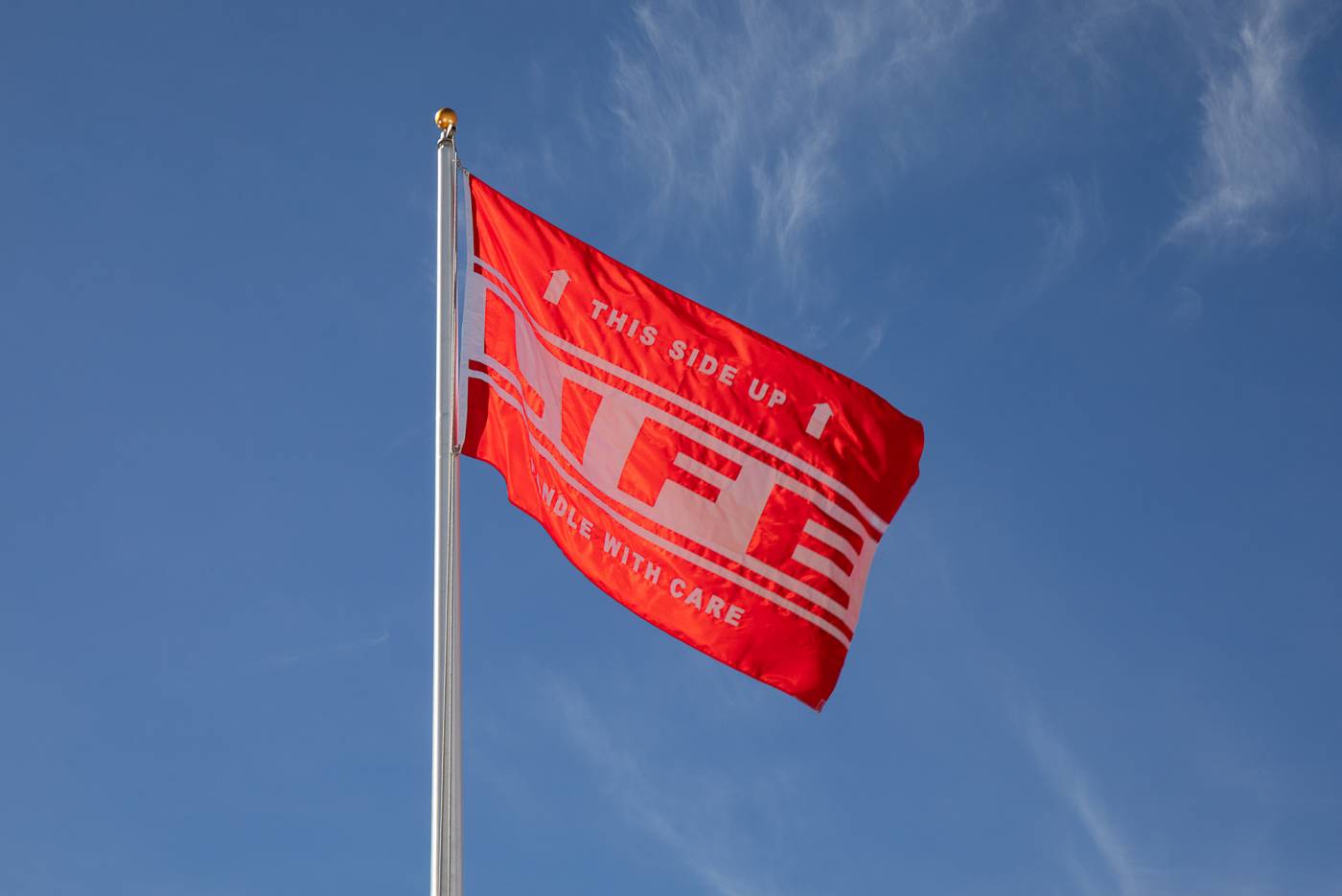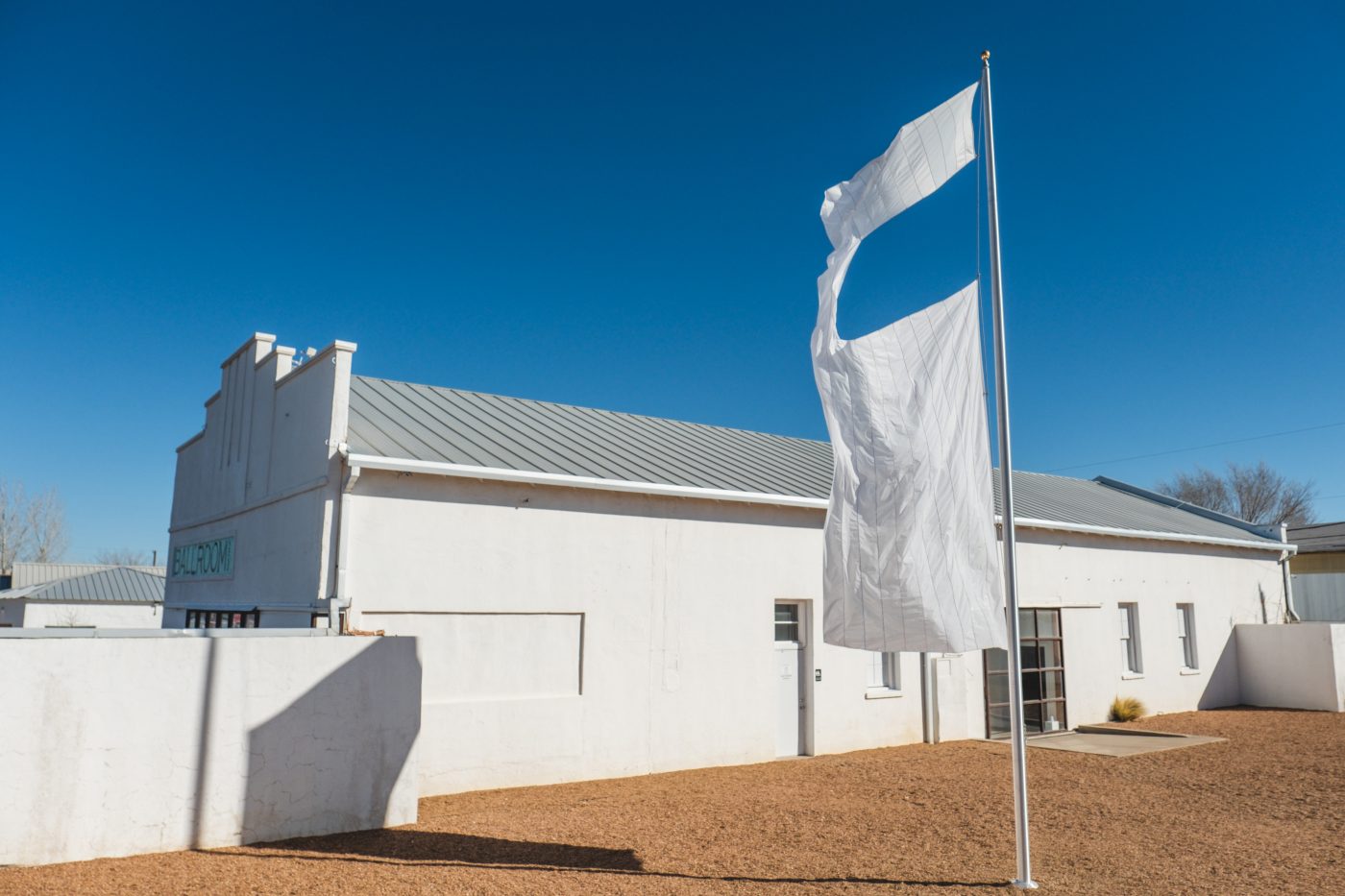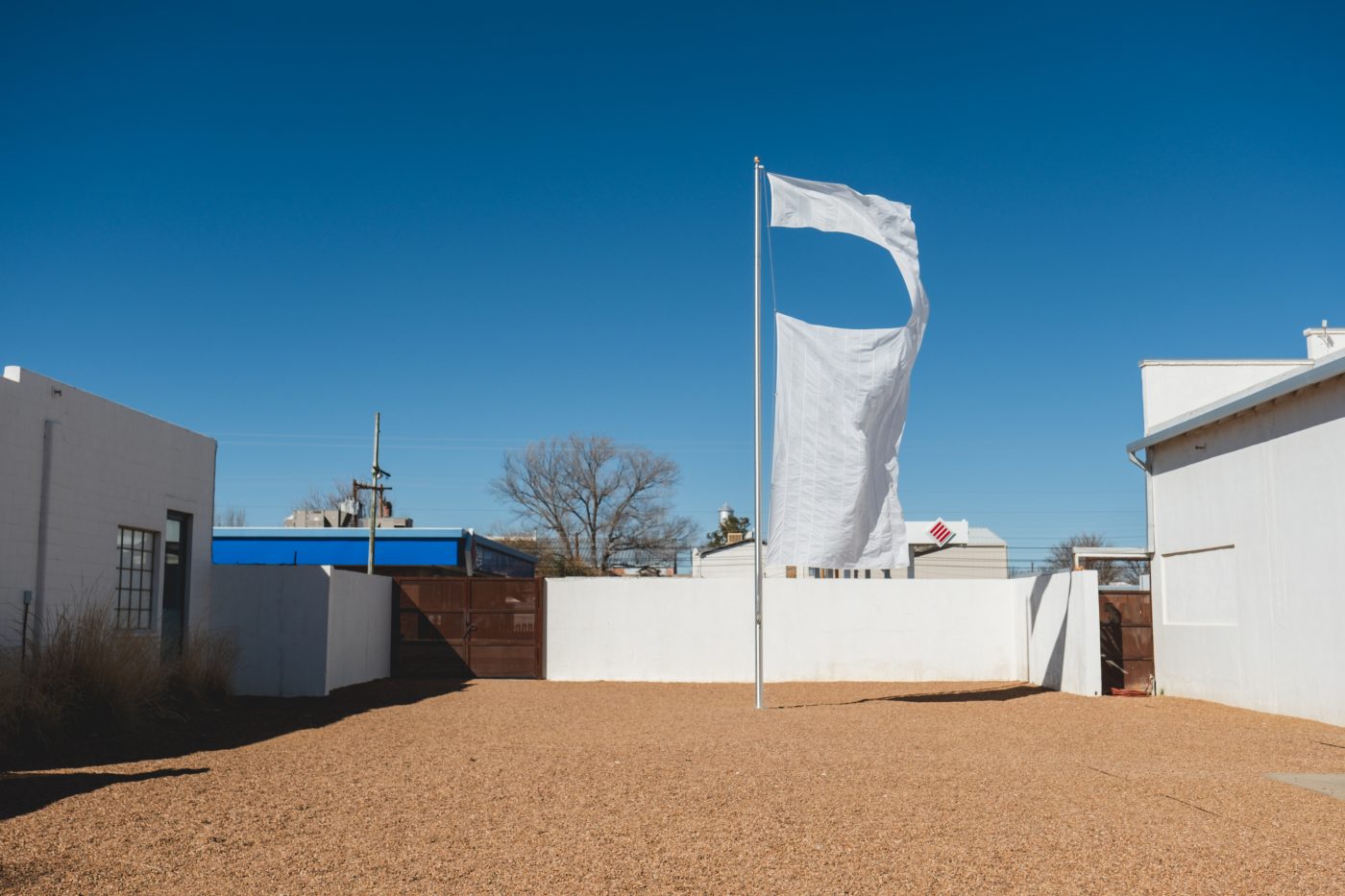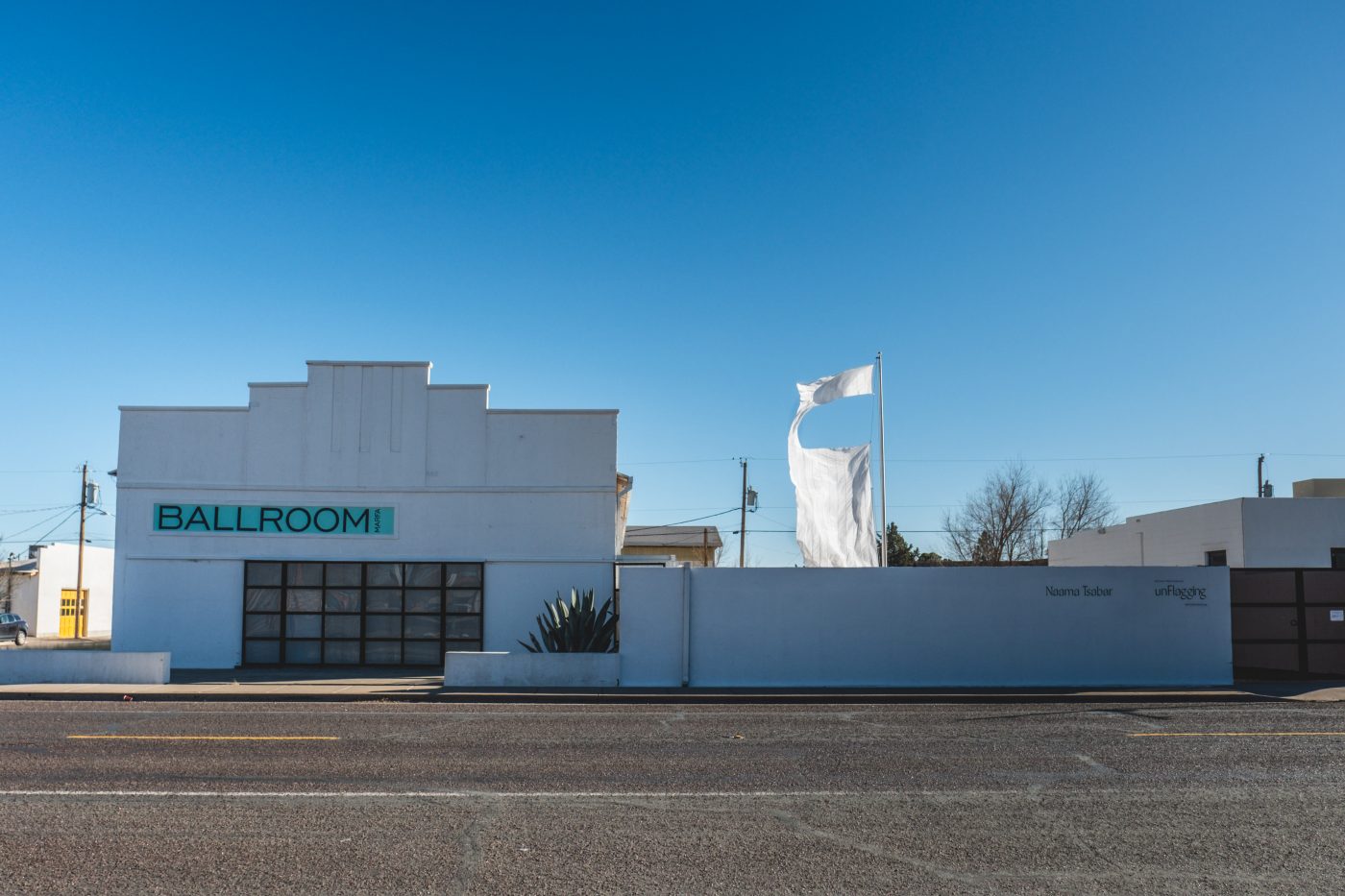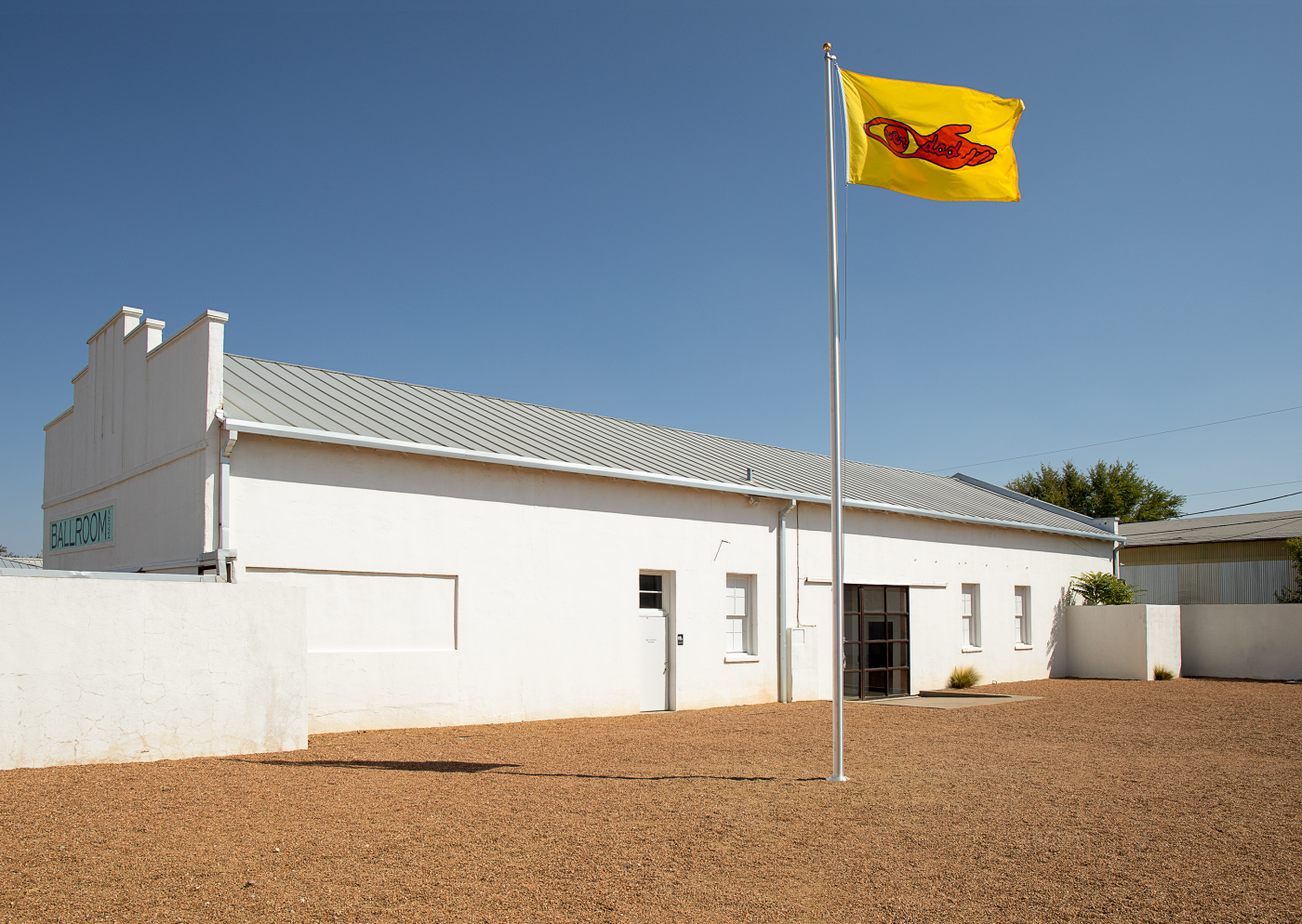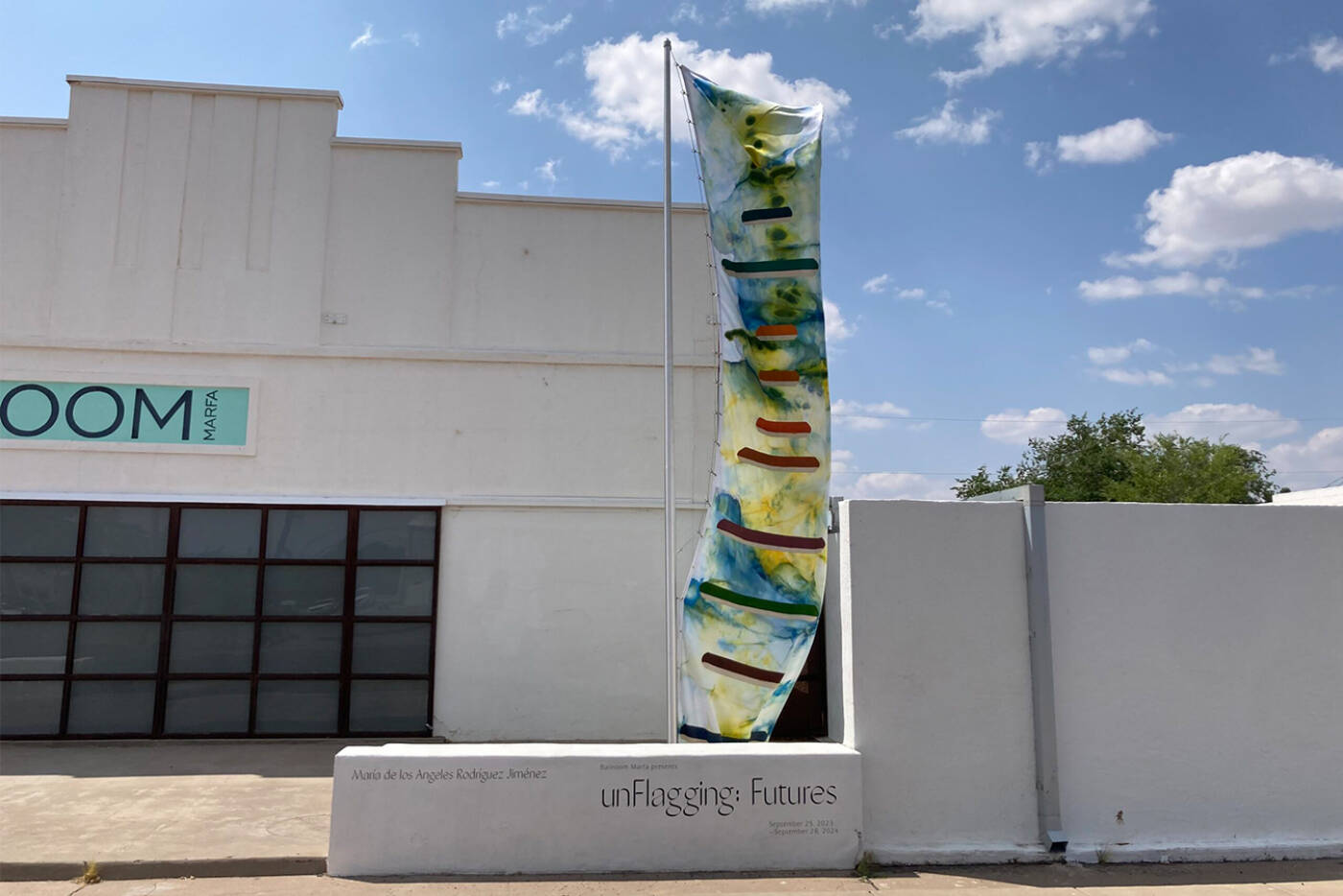
Exhibition
Lisa Alvarado, Pia Camil, Jeffrey Gibson, Byron Kim, Kameelah Janan Rasheed, Hank Willis Thomas, Naama Tsabar, Cecilia Vicuña
This fall Ballroom Marfa presents an outdoor exhibition from October 2, 2020 through February 18, 2021 that features new commissions from eight noted artists. Each artist has created a flag accompanied by a sound-based work that will be on view individually for two weeks, rotating through each artist in the series from October to January. Artists include: Lisa Alvarado, Pia Camil, Jeffrey Gibson, Byron Kim, Kameelah Janan Rasheed, Hank Willis Thomas, Naama Tsabar, and Cecilia Vicuña.
The exhibition unFlagging reconsiders flags and their symbolic meaning in our collective consciousness and country, today. Flags communicate beliefs and values in the public landscape. They are inherently performative–they declare, demarcate, and signal. As citizens, we learn to raise them, lower them, fold them, sing to them, and respect them.
The customary use of flags as vehicles to uphold and perform established principles can be challenged. The recent ruling to remove and reexamine Mississippi’s state flag, which displays confederate iconography, for example, reveals not only the power and importance of these symbolic objects, but a shift in consciousness. In this time of social transformation, we invite artists to rethink the immutability and nature of flags. How is meaning constructed, produced, and perpetuated? Can we invent new ways to make symbols and meanings?
Animated by the wind, rain, and light of West Texas, these artists’ flags reflect change and challenge constancy. Visual elements of design, color, and shape are all considered in each flag to create a multiplicity of readings. Additionally, the accompanying sound works are not a singular song sung in allegiance; rather, each artist creates a sonic environment that further activates Ballroom’s courtyard to engage with their particular flag. There is a shared experience around sound, reminding us of the multitude of voices that create space for public discourse.
This exhibition is organized by Laura Copelin, curator-at-large, Sarah Melendez, programs director, and Daisy Nam, curator.
Schedule of Flags
Each flag and sound installation will rotate every two weeks
Oct 2: Cecilia Vicuña
Oct 16: Byron Kim
Oct 30: Hank Willis Thomas
Nov 13: Pia Camil
Nov 27: Jeffrey Gibson
Dec 11: Lisa Alvarado
Dec 25: Naama Tsabar
Jan 22: Kameelah Janan Rasheed
While Ballroom’s indoor gallery spaces remain temporarily closed, audiences can engage with unFlagging from a safe distance, outdoors.
Watch
Cecilia Vicuña
We begin our exhibition unFlagging with Cecilia Vicuña’s flag Ver Dad (1974/2020) and sound work Que despierte la verdad (2020), made in collaboration with Ricardo Gallo. The flag’s powerful imagery and vibrant colors originate from a 1974 drawing made while the artist was living in London, after fleeing the Pinochet regime in Chile. The drawing is part of a series, PALABRArmas, an invented word by Vicuña, which translates to “word weapons” or “word arms.”
The flag is an offering for us to see the truth of this moment. Placed at the center of an eye is the word “ver,” which translates to “to see,” alongside the word “dad” in the palm of a hand. Put together “verdad” means “truth.” With the sound work we are also invited to feel, as Vicuña’s haunting incantation awakens our senses.
Artist Profile
Artist-poet Cecilia Vicuña (b.1948) creates songs, performances, installations, paintings, films, written works, books, lectures, and sculptures. Vicuña’s work is always attentive to ethics, the earth, and history. Her object making includes “precarios” – precarious works – composed of fragile materials that disappear, regenerating the life force, and large-scale installations of “quipus,” dyed wool and fibers inspired by the complex Andean record keeping system of sets of knotted cords. Her improvisatory, participatory performances emphasize the collective nature of action and creativity to bring forth justice, balance and transformation of the world. Cecilia Vicuña’s solo exhibit About to Happen opened at MoCA North Miami in December, 2019. Her retrospective Seehearing the Enlightened Failure recently traveled from the Witte de With in Rotterdam to MUAC in Mexico City, where it opened in February, 2020. Her works are included in the collections of Tate London, MoMA New York, Guggenheim Museum, Museo de Arte Contemporaìneo de Chile, Museo de Arte de Lima and Museo Nacional de Bellas Artes de Santiago de Chile. In 2017, her work was part of the 14th Documenta in Athens, Greece and Kassel, Germany. Vicuña is the author of 25 books.
Byron Kim
In the Sky Blue Flag series, Byron Kim attempts a near impossible task: making a flag disappear in the sky. In the vein of abstract painting, the work complicates the relationship of image, object and ground, while also deconstructing the symbolism that flags bear, as Jasper Johns had done with his Flags series.
In Marfa, Kim’s Sky Blue Flag (2020) uses the 4:7 ratio of the Mexican flag rather than the United States’s 4:6 ratio. The color is matched to the skies of Ciudad Juárez, Mexico, where the flag was fabricated in collaboration with NI EN MORE, women’s activist and sewing studio. The color is achieved using natural indigo dye, which will slowly fade over the duration of the flag’s installation. The resulting white flag perhaps signals a challenge to fixed claims of nationhood and territories.
Previous iterations of Sky Blue Flag include: Sharjah Biennial, Sharjah, U.A.E (2015), Anyang Public Art Project, Anyang, S. Korea (2016), Real DMZ Project, Soi Mountain, S. Korea (2018), and James Cohan Gallery, New York City, U.S.(2018).About NI EN MORE: Founded by artists Lise Bjorne Linnert and Janette Terrazas with human rights activist Veronica Corchado, NI EN MORE is a social innovation project merging political activism, fashion and art. Its core mission is to provide a safe environment, fair wages, education and training to women living in vulnerable conditions.
Artist Profile
Byron Kim (b.1961) is best known for his painting Synecdoche, which was included in the 1993 Whitney Biennial. Comprising a grid of panels depicting human skin color, the work is both an abstract monochrome and an ongoing group portrait. His weekly series of Sunday paintings, in which he paints the sky and on which he inscribes a journal entry, combines the cosmological and the quotidian. Kim received a B.A. in English at Yale University in 1983 and attended the Skowhegan School of Painting and Sculpture in 1986. Among his numerous awards are the Robert De Niro, Sr. Award (2019), a Guggenheim Fellowship (2017), the Alpert Award in the Arts (2008), the Joan Mitchell Foundation Grant (1997) and the National Endowment for the Arts Award (1995). Among the institutions which have collected his work are the Art Institute of Chicago, the Berkeley Art Museum, the Brooklyn Museum, the Hirshhorn Museum, the Museum of Contemporary Art San Diego, the National Gallery of Art, and the Wadsworth Atheneum.
Hank Willis Thomas
Hank Willis Thomas appropriates the design and form of a shipping label for his work in unFlagging. Titled, Life, Handle with Care, Thomas alters the customary text by replacing “Fragile” with “Life” so that it reads: “This Side Up LIFE Handle with Care.” Thomas shifts symbols and language and reintroduces them into contexts that create new readings and meaning.
In art institutions these shipping labels are ubiquitous, affixed to every crate transporting artwork. Extreme care is given to inanimate objects as they are circulated around the world. Thomas’s flag asks us to question–what about people who are living and breathing in our communities? Can we give them as much care as we do to art objects? How do we attend to the needs of our fellow citizens? The red-hot color of the flag is a burning call to reconsider what care looks like today.
Ballroom Marfa took the cue from Hank Willis Thomas’s flag and For Freedoms to consider care at this moment in our immediate surroundings. Last week on Election Day, November 3rd, we and our community partners Big Bend Sentinel, Communitie, Convenience West, Judd Foundation, KMKB and Marfa Steps Up served free to-go BBQ for those who voted. Marfa had a historic turnout record for this year’s election.
We also gave out Life, Handle with Care stickers with a QR code, where you can listen to a mix of audio ranging from interviews to messages to music.
Artist Profile
Pia Camil
Pia Camil breaks the conventional form and function of a flag. Applying abstracted symbols on rectangular fabric is perhaps inadequate in representing a group of people. For AIR OUT YOUR DIRTY LAUNDRY, Camil instead makes a portrait of Marfa using residents’ laundry. The artist asked the people of Marfa to donate personal items of clothing or bedding to be hung from the flagpole in Ballroom’s courtyard to the building’s facade. Audio recordings of participants sharing the meaning of donated items accompanies the outdoor installation. In exchange, participants received a voucher for a free load of laundry at Tumbleweed, Marfa’s local laundromat.
For Camil, intimate items that live close to our bodies on a daily basis such as clothes or bed sheets contain our sweat and secrets; they bear witness to our moments of joy and sadness. Dirty laundry in this exhibition is foregrounded and celebrated rather than hidden.
Artist Profile
Pia Camil (b. 1980) lives and works in Mexico City. Camil’s work is usually associated with the Mexican urban landscape, the aesthetic language of modernism and its relationship to retail and advertising. Recently she has engaged in public participation as a way to activate the work and engage with the politics of consumerism.
Camil has a BFA from the Rhode Island School of Design and an MFA from the Slade School of Fine Art, London. Her work has been exhibited internationally with recent solo-exhibitions including: Laugh Now, Cry Later at OMR Gallery, Mexico City (2020); Here Comes The Sun, performance at Guggenheim Museum, New York (2019); Fade into Black: Sit, chill, look, talk, roll, play, listen, give, take, dance, share, Queens Museum, New York (2019); Bara, Bara, Bara, Tramway Art Space, Glasgow (2019); Telón de Boca, Museo Universitario del Chopo, Mexico City (2018); Split Wall, Nottingham Contemporary (2018); They, Galerie Sultana, Paris (2018); Bara, Bara, Bara, Dallas Contemporary (2017); Slats, Skins & Shopfittings, Blum & Poe, New York (2016); A Pot for a Latch, New Museum, New York (2016); Skins, Contemporary Arts Center, Cincinnati (2015); The Little Dog Laughed, Blum & Poe, Los Angeles (2014); Espectacular Telón, Galerie Sultana, Paris (2013); Cuadrado Negro, Basque Museum Centre for Contemporary Art, Vitoria-Gasteiz, Spain (2013).
Jeffrey Gibson
Two lone stars appear on Jeffrey Gibson’s flag one becomes the other, 2020. When the flag remains still, the individual stars never quite touch, but as the flag waves and flaps with the wind, they begin to move together and merge. Their interplay is further animated by music from Laura Ortman, which emanates from Ballroom’s courtyard.
The flag’s symbol is a nod to the exhibition’s site in Texas, the Lone Star State. More notable is the influence of Lone Star quilts of Indigenous Peoples. Created from intricately sewn pieces of fabric that form an eight-pointed star, the quilts feature concentric diamonds patterns radiating from the center. The star’s pulsating effect is further enhanced by vibrant and complex color arrangements. Lone Star quilts are made as gifts and given to honor individuals at milestones throughout one’s life. The artist’s introduction to these aesthetic and ritual traditions came through observing his own grandmothers’ quilting. Gibson’s flag foregrounds the geometric abstraction of Native women quilters, expanding our knowledge of craft and modernism.
Artist Profile
Jeffrey Gibson (b.1972) draws influence from popular music, fashion, literature, cultural and critical theory, and his own individual heritage, Jeffrey Gibson’s work recontextualizes the familiar to offer a succinct commentary on cultural hybridity and the assimilation of modernist artistic strategies within contemporary art. Gibson’s Cherokee and Choctaw lineage has imparted a recognizable aesthetic to his beaded works exploring narrative deconstructions of both image and language as transmitted through figuration. Known for his reappropriation of both found and commercial commodities – ranging from song lyrics to the literal objecthood of Everlast punching bags – repurposed again through Minimalist and post-Minimalist aesthetics, speaks to the revisionist history of Modernist forms and techniques. The resulting sculptures and paintings seamlessly coalesce traditional Native American craft with contemporary cultural production and references, forming works that speak to the experience of an individual subjectivity within the larger narrative defining contemporary globalization.
Lisa Alvarado
A thalweg is the lowest elevation in a river, a pathway of shifting water and sediment. It is also the median that defines international borders in a waterway. It traces the divide between the Rio Grande and Rio Bravo, for example, on the politicized Mexico–US Border.
Thalweg Flag, by visual artist and musician Lisa Alvarado, demarcates an intervening space for healing physical, psychological and spiritual borders between people. The flag recognizes borderland waterways as a vital artery of converging multiplicity. The yellow colors of the flag recall yellow bracelets imposed on families separated at the border. The flag’s symbology acknowledges the power of transformation and intercedes to overcome artificial boundaries and forced separations in favor of unification.
The flag in Ballroom’s courtyard is further animated by “Sounds for Thalweg Flag” by Natural Information Society, an ensemble founded by Joshua Abrams that features Alvarado on harmonium. The sound work, which includes newly composed, improvised and found sound, builds from components of “Thalweg Sounds,” a composition developed for Alvarado’s solo exhibition Thalweg at the Bridget Donahue Gallery in Summer 2020. With “Sounds for Thalweg Flag” Alvarado considers a liminal space, a fluid pathway of shifting water and sediment where layers of memory continuously mix and reconfigure.
“Thalweg is an ongoing series of work that I began in 2019. I was born and raised in San Antonio. My Tejano family goes back many generations throughout south Texas. Cycles of suppression and forced divisions in this area drew me to create the series. The Thalweg works offer an abstract language and material form to geography and memory.” — Lisa Alvarado
Artist Profile
Lisa Alvarado (b. 1982) is an artist and harmoniumist based in Chicago. Previous solo exhibitions include Polyphonic Shadow Cloth, LC Queisser, Tbilisi, Georgia (2018); Sound Talisman, Bridget Donahue, New York (2017) and Traditional Object, Soccer Club Club, Chicago (2013). Recent group exhibitions include Psychedelic Healing Center, Essex Flowers, New York (2019); Out of Easy Reach, Gallery 400, Chicago (2018); Alan Shields Project, Van Doren Waxter, New York (2018); The Freedom Principle: Experiments in Art and Music, 1965 to Now, Institute of Contemporary Art, Philadelphia (2017) and Museum of Contemporary Art, Chicago (2016) and Material Issue, KMAC Museum, Louisville (2016), among others. Alvarado plays harmonium in the psych-minimalist band Natural Information Society. They have performed in numerous venues including Pitchfork, Chicago (2018); Rewire, Netherlands (2018); Institute of Contemporary Art, Philadelphia (2017) and Serralves Museum, Portugal (2016). In addition to releasing albums on Eremite Records & Drag City Records, she has also performed with Theaster Gates’s Black Monks at Palais De Tokyo (2019) and Documenta 13 (2012); and in Simon Starling’s play At Twilight, Common Guild, Glasgow (2016) and Japan Society, New York (2020)
Naama Tsabar
From a distance, Tsabar’s flag Untitled (Without), 2020, is a long piece of fabric with a rectangular cut-out. Where we expect to see a flag, we instead see empty space. In the courtyard, the flag’s details are seen and experienced on a more intimate scale. With closer inspection, the flag is made of white strips of fabric that are sewn together with colored stitches. The colors derive from the LGBTQIA+ Progress Pride Flag, an updated version of the iconic LGBT Rainbow Flag. Untitled (Without) suggests that perhaps identity is far more subtle than the bold symbols and objects that attempt to represent us.
Tsabar’s installation includes a sonic work titled Ruptures (Opus 1) featuring several voices of women singing, sighing, groaning, and breathing. Ruptures (Opus 1) explores the female musical voice as a “historically expressive anomaly, a place where a disruption of the patriarchal order happens under the cover of beauty and melody,”says the artist. As the voices reverberate throughout the courtyard alongside the flag, we are reminded to recognize the unseen and undefined that can hold power.
Artist Profile
Naama Tsabar (b. 1982 ) employs sculpture, photography, and performance to subvert the gender roles historically
associated with musicianship. Appropriating and subverting the aggressive gestures of rock and roll and their associations with virility and power, Tsabar upends the implicit gender roles and coded behavior of music and nightlife. Her most recent works and sonic installations weave together iconic actions and objects from rock music (the guitar, the amplifier, the microphone) with a more intimate portrayal of the artist’s body and its movement through, within, and into the surrounding architecture. The motifs of femininity, gender, disruption, destruction and reconstruction recur throughout her work and performances. Recent performances include Composition 21, a sound work commissioned by the Nasher Museum of Art to inaugurate its new sculpture garden in 2019 and performances at Frieze Projects, Los Angeles in 2020. Tsabar has also preformed at ELEVATION 1049 in Gstaad, Switzerland, in February 2019, and exhibited at the Center for Contemporary Art in Tel Aviv in 2018, Kunsthaus Baselland in 2018, and Prospect New Orleans in 2017. Upcoming exhibitions include The Musical Brain, a group organized by Cecilia Alemani for the High Line, and Fantasy America at the Andy Warhol Museum, Pittsburgh. Selected exhibitions and performances of Tsabar include Ballroom Marfa, TX, (2020-21); Schirn Kunsthalle, Frankfurt, (2019); Faena Art Center, Buenos Aires, (2018); SoundKraft at the Museum of Arts and Design, New York (2017-18); The Skin of Sound, Hessel Museum of Art / CCS Bard, New York (2018); Palais de Tokyo, Paris (2017); High Line Art, New York (2016); Guggenheim Museum, New York (2014); Tel Aviv Museum of Art, Tel Aviv (2013, 2010); Frieze Projects, New York (2014); Zacheta National Gallery of Art, Warsaw (2014); MARTE-C, San Salvador (2015); MoMA PS1, New York (2010); The Herzliya Museum for Contemporary Art, Herzliya (2006). Tsabar received her MFA from Columbia University, New York in 2010 and BFA from Hamidrasha School of Arts, Belt-Berl, Israel, in 2004. Her work is held in the permanent collections of the Solomon R. Guggenheim Museum, New York; San Francisco Museum of Modern Art, San Francisco; Tel Aviv Museum, Tel Aviv; Israel Museum, Jerusalem. Tsabar currently lives and works in New York.
Sound credit: Ruptures (Opus 1), 2019, recorded live, written in collaboration with Rose Blanshei, FIELDED, Naama Tsabar and Wolf Weston. Performed by Rose Blanshei, FIELDED, and Wolf Weston. Mixed and recorded by Bence Korompai.
Kameelah Janan Rasheed
With each passing breeze, Rasheed’s words on all things are organized as uncertainty (2021) reshuffle and recombine meaning, reminding us that flags are inherently mutable. On one side we read the words and phrases “all things are organized,” “as strange flutters of uncertainty,” “time is structured thick” each encircled in white spheres. On the reverse we see “strange flutters,” “behind this cosmic verse.” These words and spheres float atop graphics reminiscent of geological or cosmic renderings. Black and white strokes gesture towards movement and gather form with layers of pink and fuchsia circular patterns. These changing arrangements allow us to read the flag in different ways and reveal new meanings from what is visible and what is hidden, presenting a poetic gesture in motion.
As a self-described learner, Rasheed’s practice uses text and form to reveal a cosmology in constant flux. Her work uses the generative qualities of incompleteness and poetic play to help the viewer form synapses and uncover new meanings. With all things are organized as uncertainty, 2021, the statements in motion provoke the reader to pause and reflect on what it means to read effectively, thoroughly, closely.
“If the words never settle and we are consistently engaged in acts of [un]learning, then that means I must stay attuned to generative and interdependent Black storytelling methodologies that nurture us in ways of reading, writing, speaking, listening, archiving, and knowing that challenge finality, enclosure, fixed meaning, and the death of capture.” – Kameelah Janan Rasheed
Kameelah Janan Rasheed (b. 1985) is invested in the shifting ecosystems of Black epistemologies, and the agile relationships between the varied modes of reading, writing, archiving, editing, translating, publishing, reflecting upon, and arranging narratives about lived Black experiences. With interests in the generative qualities of incompleteness, leakage, dispersal, syncretism (spiritual and otherwise), and choreography (of movement, of learning, of affect), Rasheed works across an ecosystem of iterative and provisional projects. These projects include sprawling, architecturally-scaled Xerox-based collages; large-scale text banner installations; publications; digital archives; lecture-performances; library interventions; poems/poetic gestures; and other forms yet to be determined. Rasheed has exhibited at the 2017 Venice Biennale; CCA Wattis Institute for Contemporary Arts, San Francisco; Institute for Contemporary Art Philadelphia; Pinchuk Art Center, Kiev, Ukraine; Mass MoCA, Williamstown; Brooklyn Museum, NY; Queens Museum, NY; New Museum, NY; Studio Museum in Harlem, NY; Bronx Museum, NY; Brooklyn Public Library, NY; Schomburg Center for Research in Black Culture, NY, and The Kitchen, NY, among others. She is the author of two artist books, An Alphabetical Accumulation of Approximate Observations (Endless Editions, 2019) and No New Theories (Printed Matter, 2020).
Installation images
Acknowledgements
unFlagging is made possible by the generous support of The Brown Foundation, Inc.; Humanities Texas; Lebermann Foundation; National Endowment for the Arts; Texas Commission on the Arts; Ballroom Marfa’s Board of Trustees; Ballroom Marfa International Surf Club and Ballroom Marfa members.
Special thanks to artists and Helen Banach, Brian Barlow, Blum & Poe, Jimena Camou, James Cohan Gallery, Dixie Flag San Antonio (Lorena Ortega & Vanessa Van de Putte), Bridget Donahue, Lilah Dougherty, Ricardo Gallo, Tal Gilboa, Mckenzie Goodman, Kristian Henson, Sikkema Jenkins & Co., Kasmin, Roberto Carlos Lange & Kristi Sword, Nora Lawrence, Lehmann Maupin, Carolyn Macartney, Ni En More (Janette Terrazas & Maritza Uscanga), Luca Piccin, Real DMZ Project, Red Canary Studio (Anne Schroth), Francisco Rosas, Bill Singer, and Gory Smelley.
